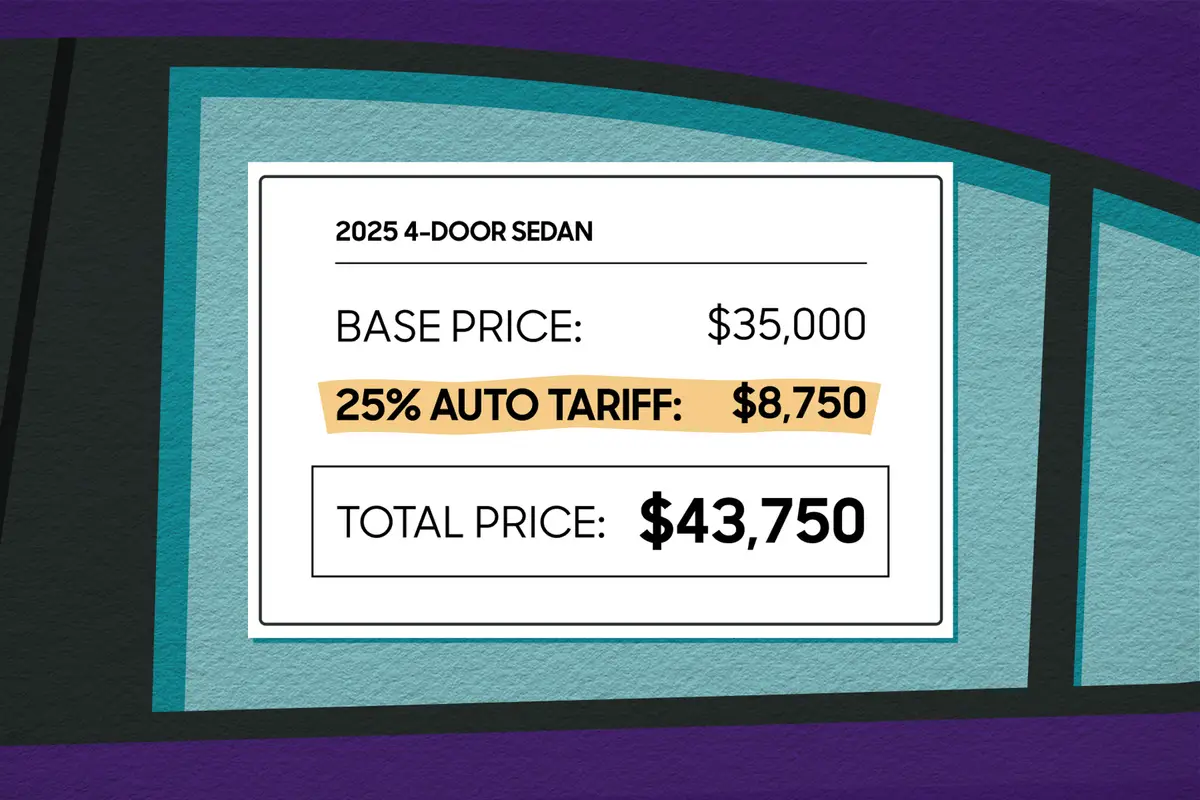2023 GMC Canyon Review: Better and Brawnier, But at What Cost?

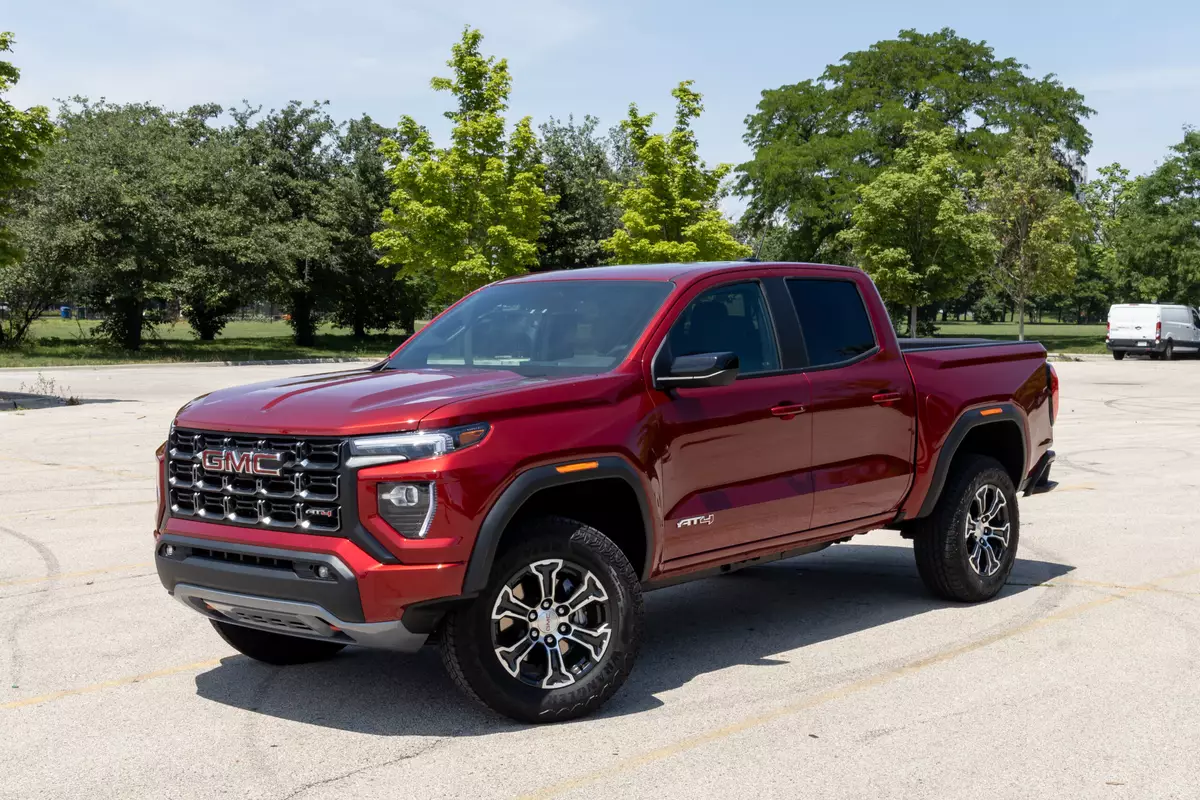
The verdict: The redesigned 2023 GMC Canyon mid-size pickup truck is significantly better and more premium than its predecessor. With a full-size feel (for better and worse), the hardest decision Canyon shoppers will have to make is how much off-roading they want to do.
Versus the competition: Along with its Chevrolet Colorado cousin, the Canyon is one of the best mid-size trucks you can buy, but its price might push buyers toward a full-size pickup instead; if not, there’s a new Toyota Tacoma on the horizon that appears poised to reassert its dominance.
GM has made great strides in the mid-size pickup truck class, and the redesigned 2023 Chevrolet Colorado really impressed us. The related GMC Canyon is also all-new for 2023, and with this truck, GMC takes a more focused approach.
Related: 2023 GMC Canyon Up Close: Abandoning the Streets for the Hills
Like the new Colorado, the 2023 Canyon is only available in crew-cab short-bed form, and the only available engine is a turbocharged 2.7-liter four-cylinder. The Canyon, however, is both more premium than the Colorado and more off-road-focused. To that end, the highest-output version of the 2.7-liter engine powers every Canyon, making 310 horsepower and 430 pounds-feet of torque, and every model comes standard with a factory lift of at least 2 inches. The interior is also far more premium than the Colorado’s; it’s among the most luxurious in the class.
The result is a capable and much-improved mid-size pickup truck that further blurs the line between full-size trucks, like GMC’s own Sierra 1500, when it comes to driving feel and price.
Drives Well for a Pickup
I spent a great deal of time behind the wheel of the Canyon, and the driving experience was mostly pleasant. Ride comfort definitely stood out; the AT4 trim level we drove had beefy all-terrain tires and a pliant off-road suspension, which helped bumps and road imperfections go unnoticed. Body control in corners was a bit sloppy but not terrible. Road and tire noise weren’t annoying, either, which isn’t always the case with off-road vehicles.
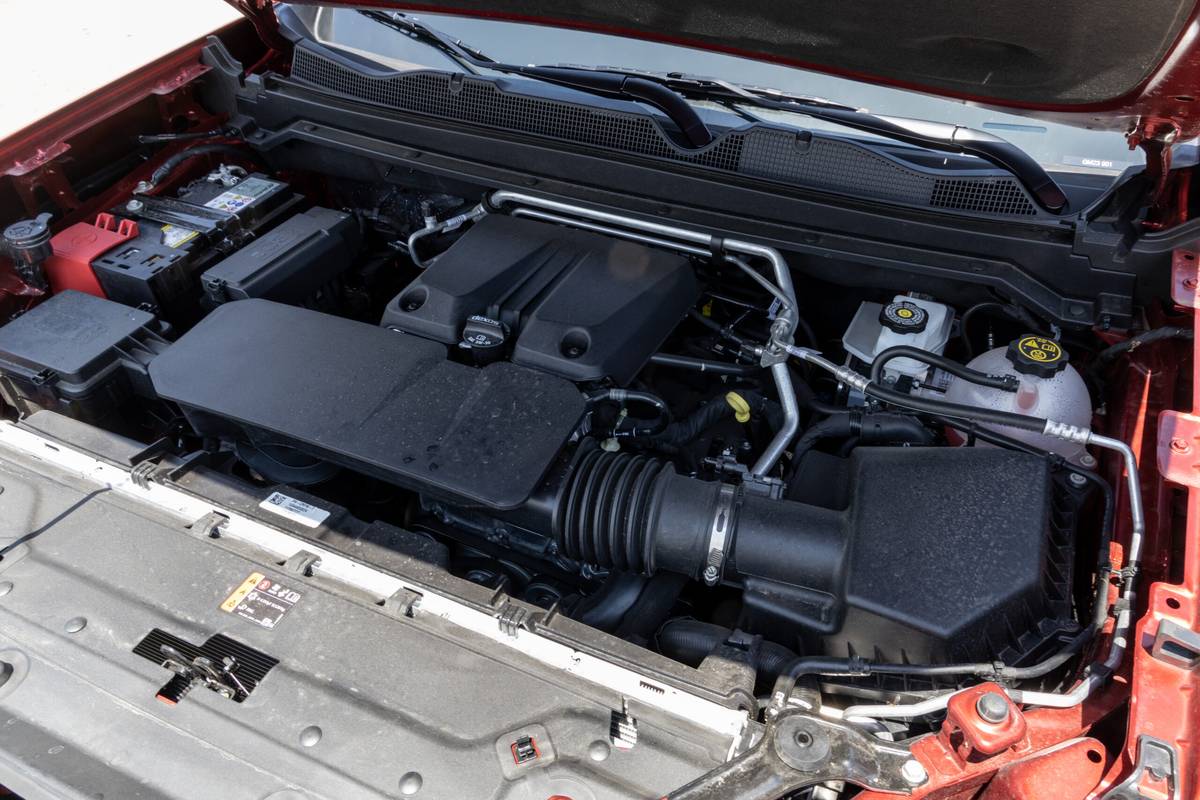
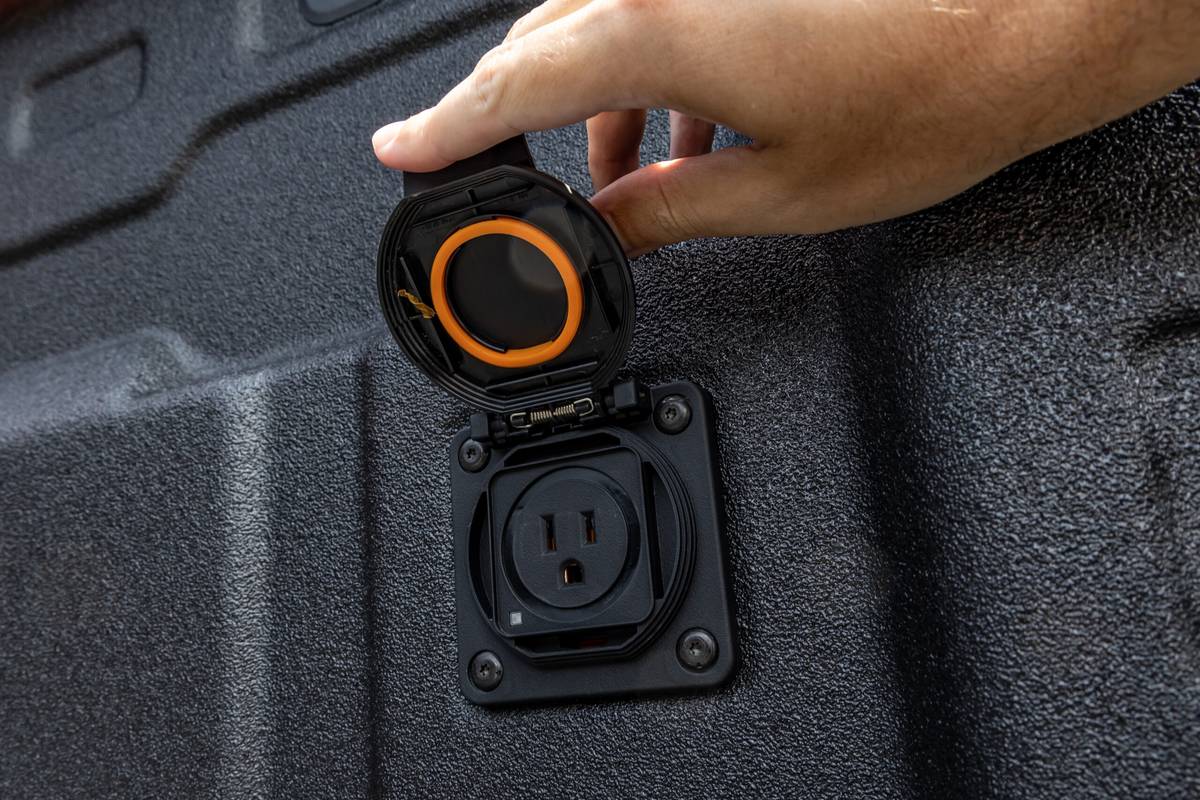
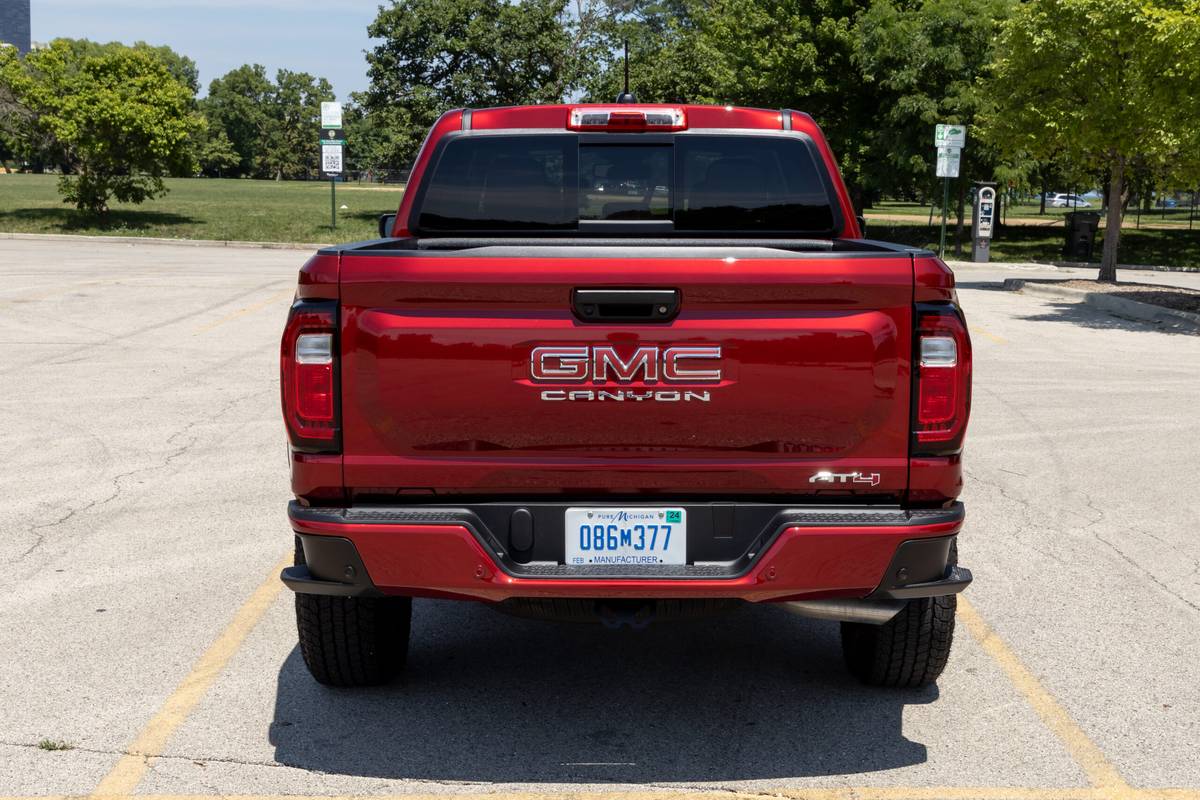
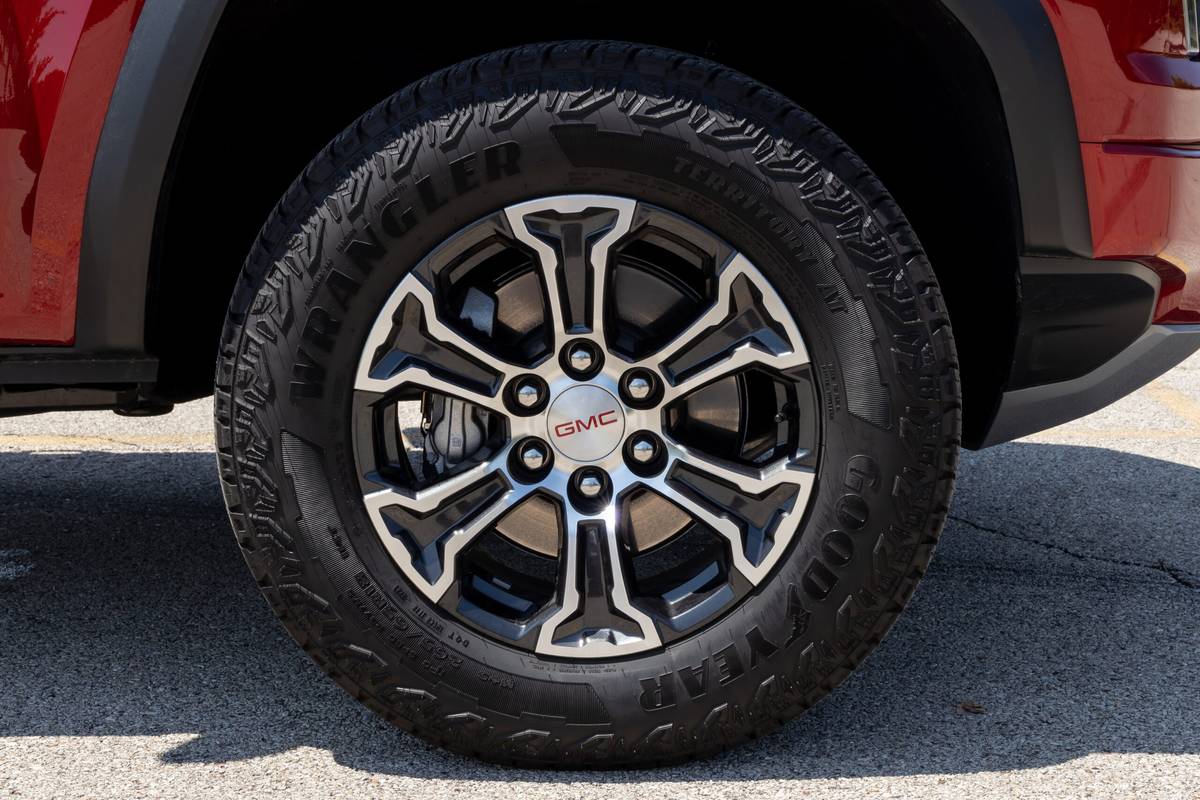
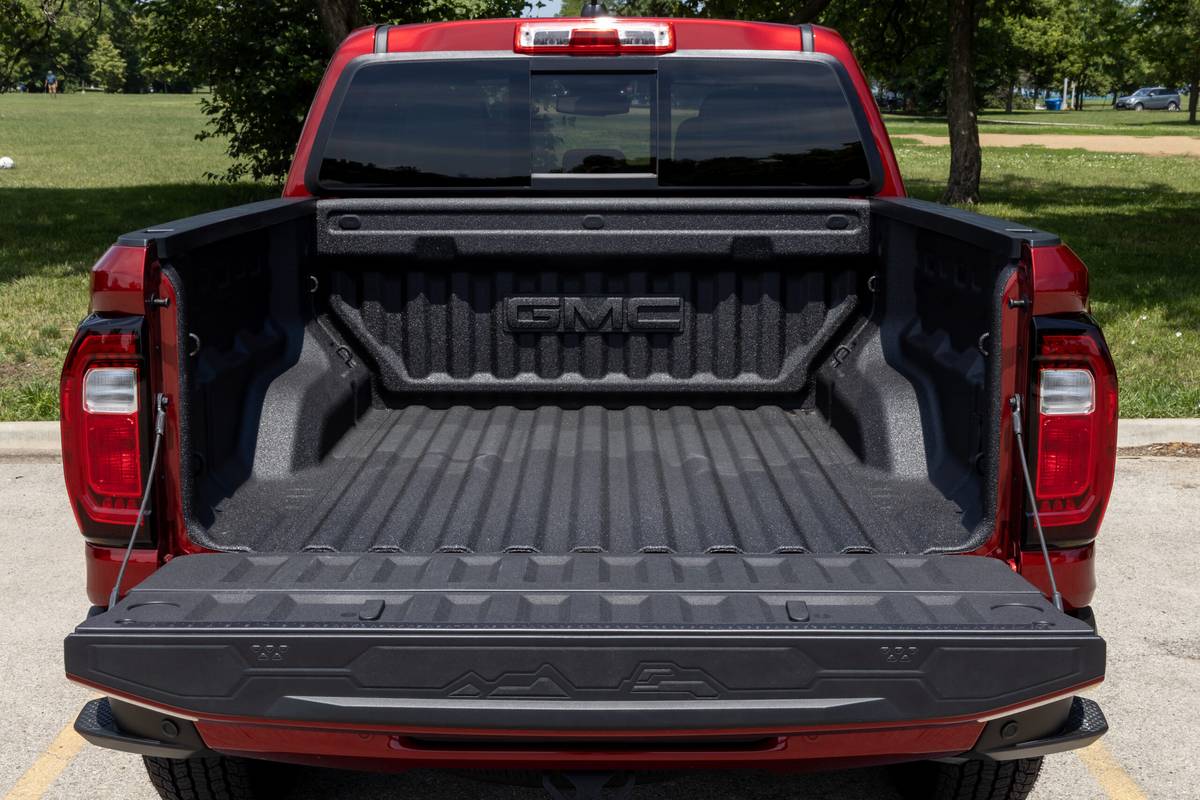
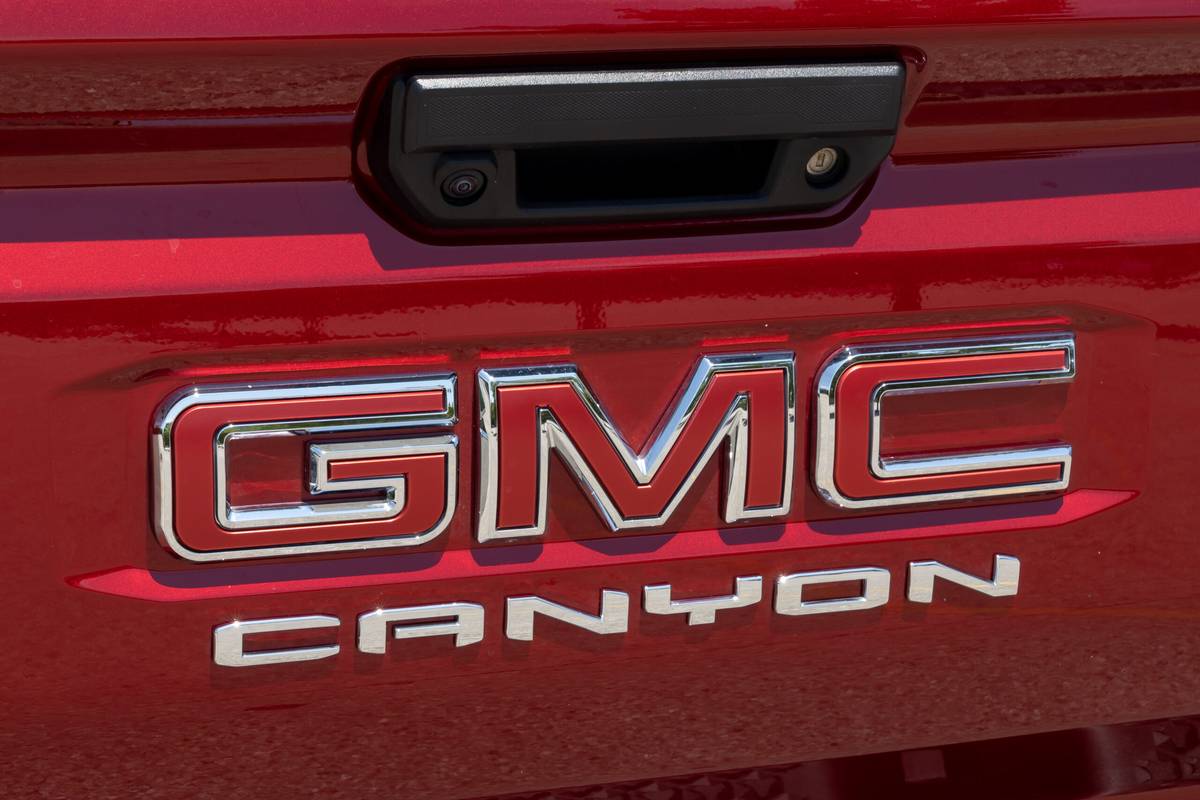
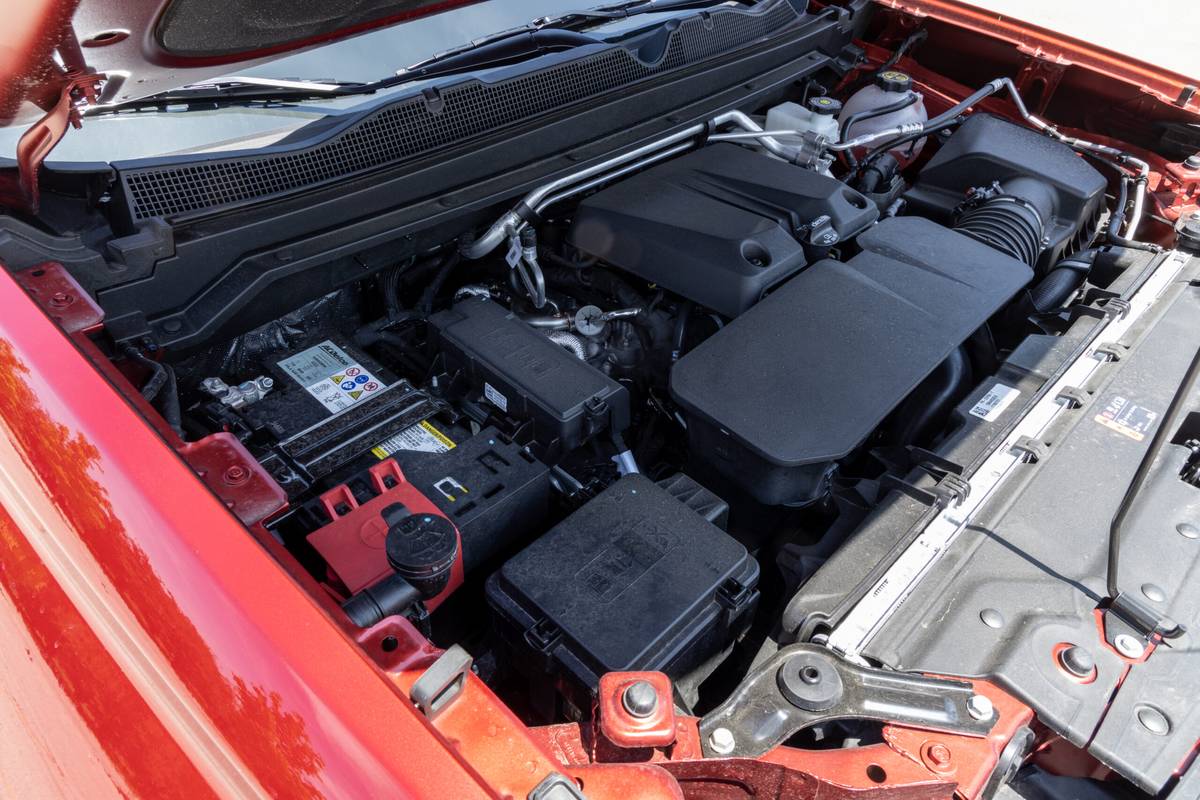
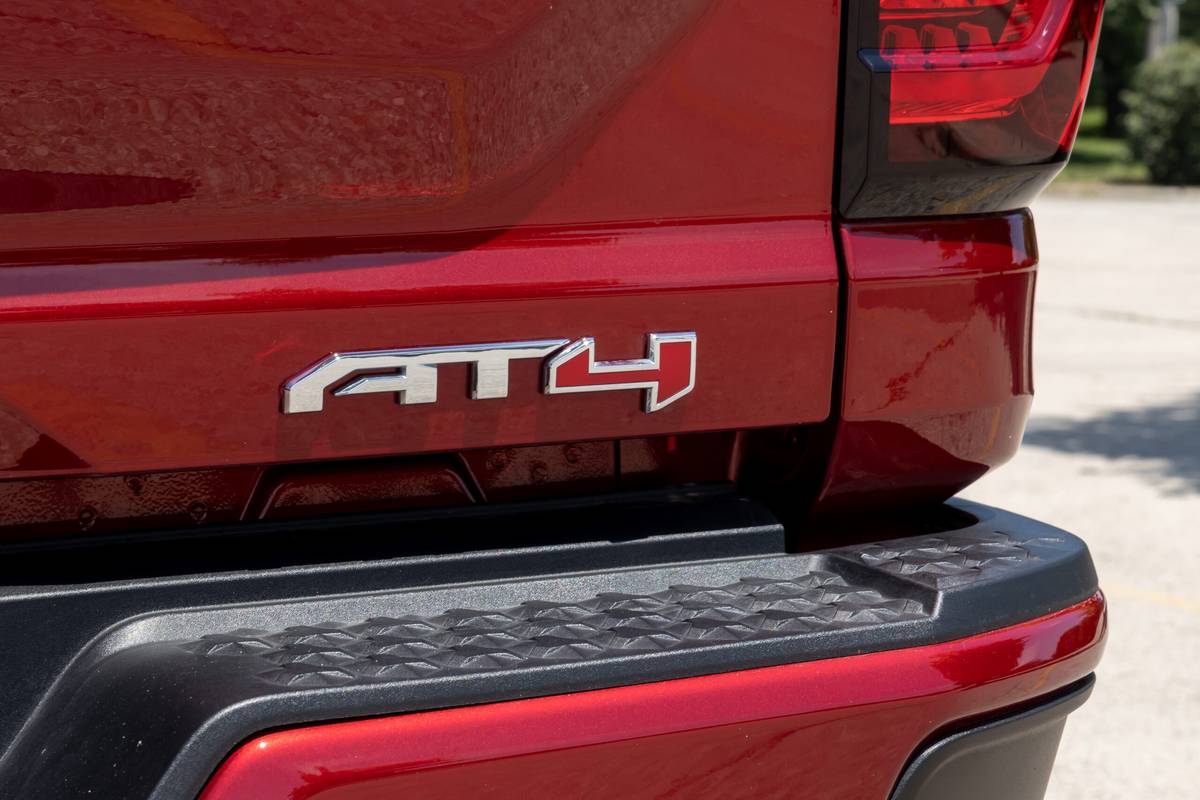
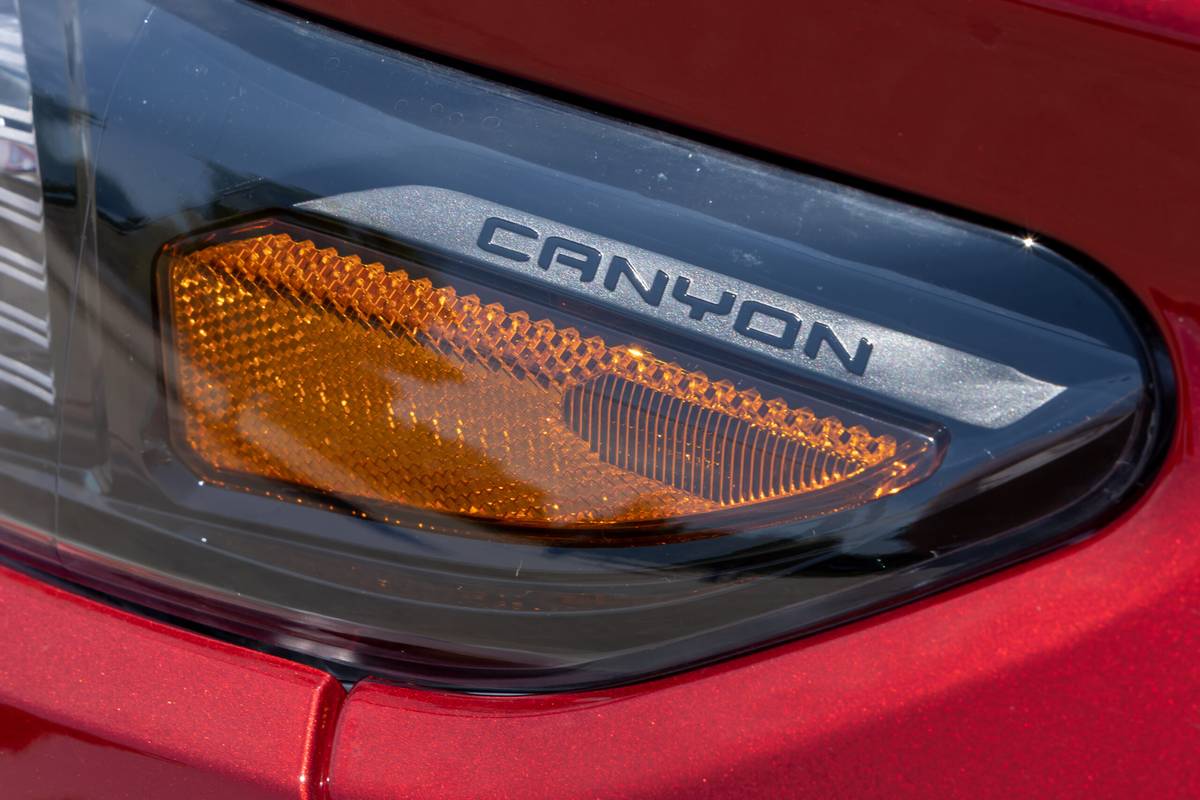



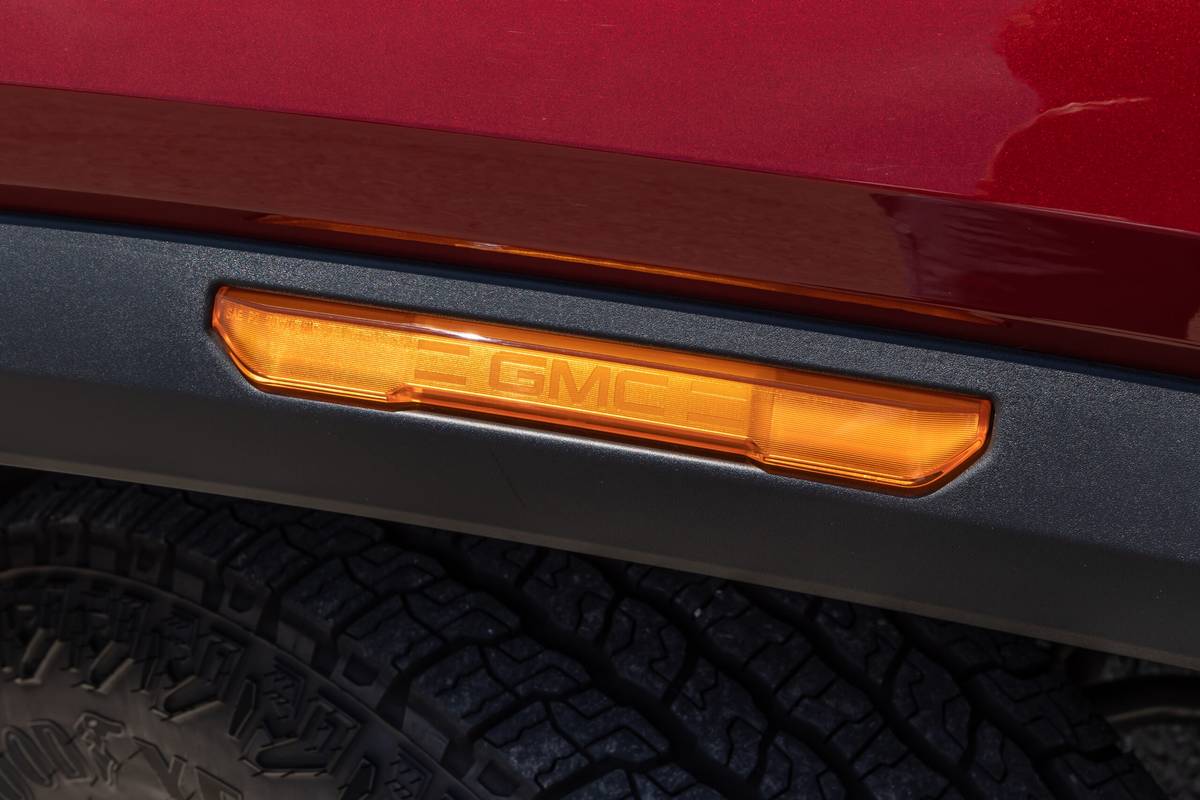
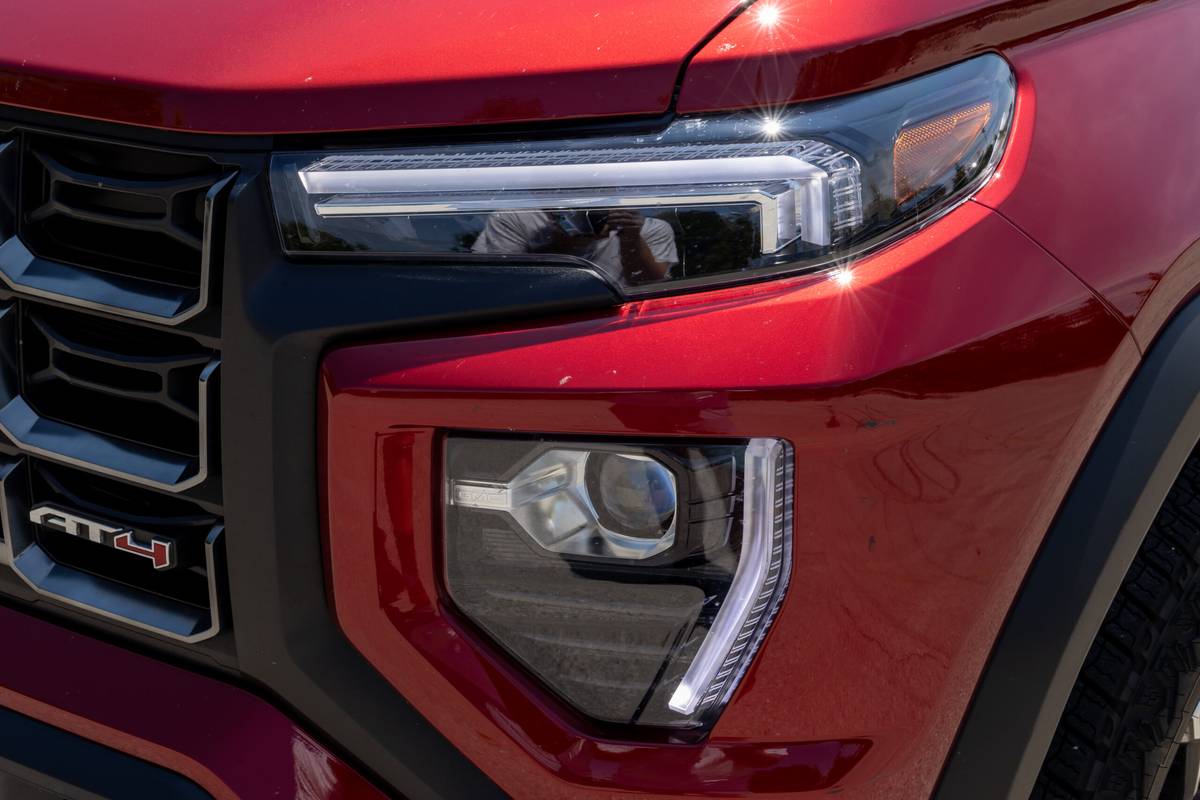
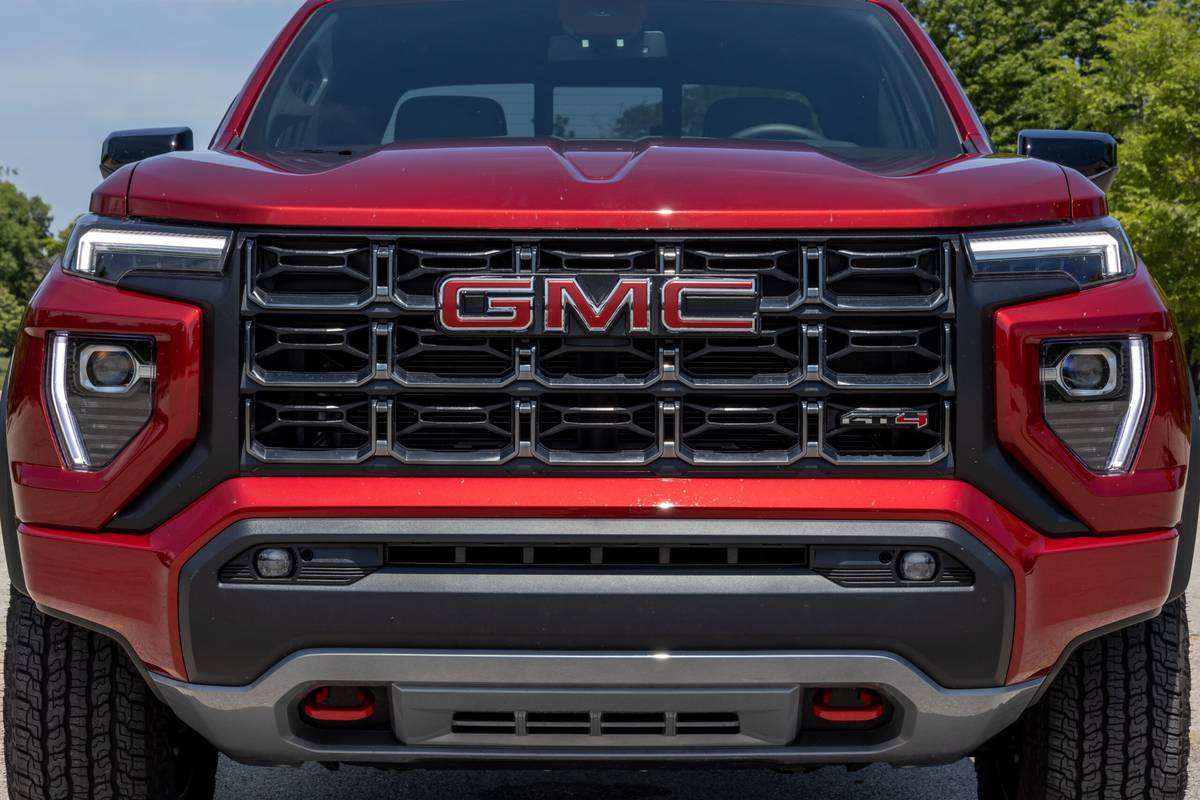
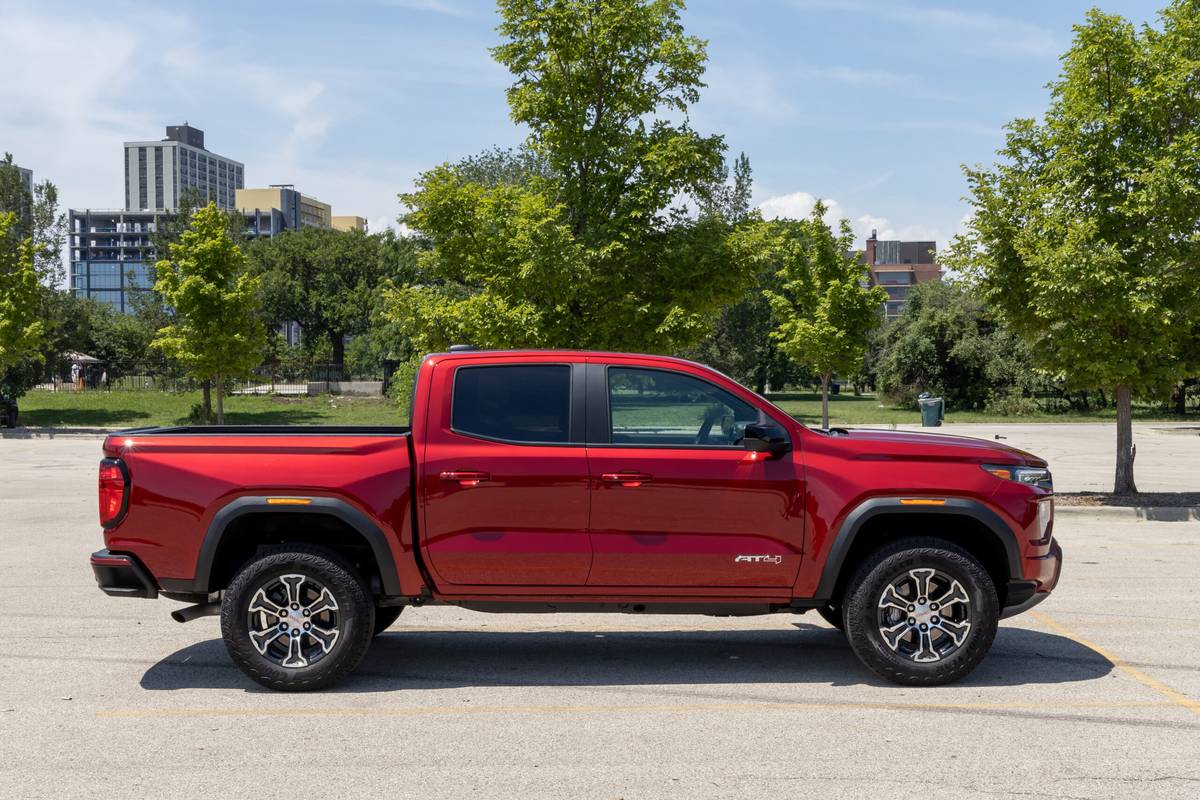
















The new 2.7-liter four-cylinder engine is an interesting one. It pairs with a standard eight-speed automatic transmission that shifts smartly, and when the engine is in its power band, it has more than adequate pulling power. It also makes significantly more torque than the previous-generation’s gas V-6, which produced 308 hp and 275 pounds-feet of torque. I do, however, also have some complaints about the turbo four-cylinder.
For one, when cruising on the highway the engine seems to sit outside its ideal rpm, so there’s sometimes a lag when you need more power (like when trying to pass); stepping on the gas pedal increases rpm, but there’s a delay before that translates into actual acceleration. There’s also the sound the new engine makes. The high-output four-cylinders that are replacing V-6s and even V-8s in many new vehicles lack the refined — sometimes even enjoyable — sounds of the engines they’re replacing. It seems to just be the nature of the beast, but it’s a shame.
Part of the reason four-cylinders are replacing larger engines is a quest for better gas mileage. In the Canyon, it didn’t work out that way: The new four-cylinder falls short of the previous-generation Canyon’s diesel engine, which was rated as high as 23 mpg combined, but even compared with the prior gas V-6, the new Canyon is less efficient. With rear-wheel drive, the V-6-powered 2022 Canyon was EPA-rated 18/25/21 mpg city/highway/combined, but the rear-drive 2023 Canyon is rated 18/23/20 mpg. With 4WD, which our AT4 version had, fuel economy with the new engine drops to 17/21/19 mpg, and it’s even worse with the mud-terrain tires on the AT4X trim at 17/20/18 mpg. With its standard lift and beefier tires, it’s unsurprising the new 2023 Canyon isn’t the most fuel-efficient mid-size pickup, but it’s still disappointing.
Other aspects of the driving experience are good — or at least not bad. Brake feel is linear, and there’s plenty of stopping power. I wasn’t as impressed, however, with the Canyon’s steering feel; its lift, off-road suspension and chunky tires make it feel a little numb on pavement.
Premium Interior
The Canyon AT4’s cabin impressed me with its premium feel. It’s not as luxurious as a decked-out Ram 1500, but it’s nicer and more upscale than most trucks in its class — which feels a little contradictory given the Canyon’s rough-and-ready exterior. Most materials and controls feel upscale, though the lower surfaces are plasticky (which makes sense in a pickup truck). The interior looks and feels far nicer than the last-generation Canyon Denali, which was a premium truck in name only. This generation really is premium.
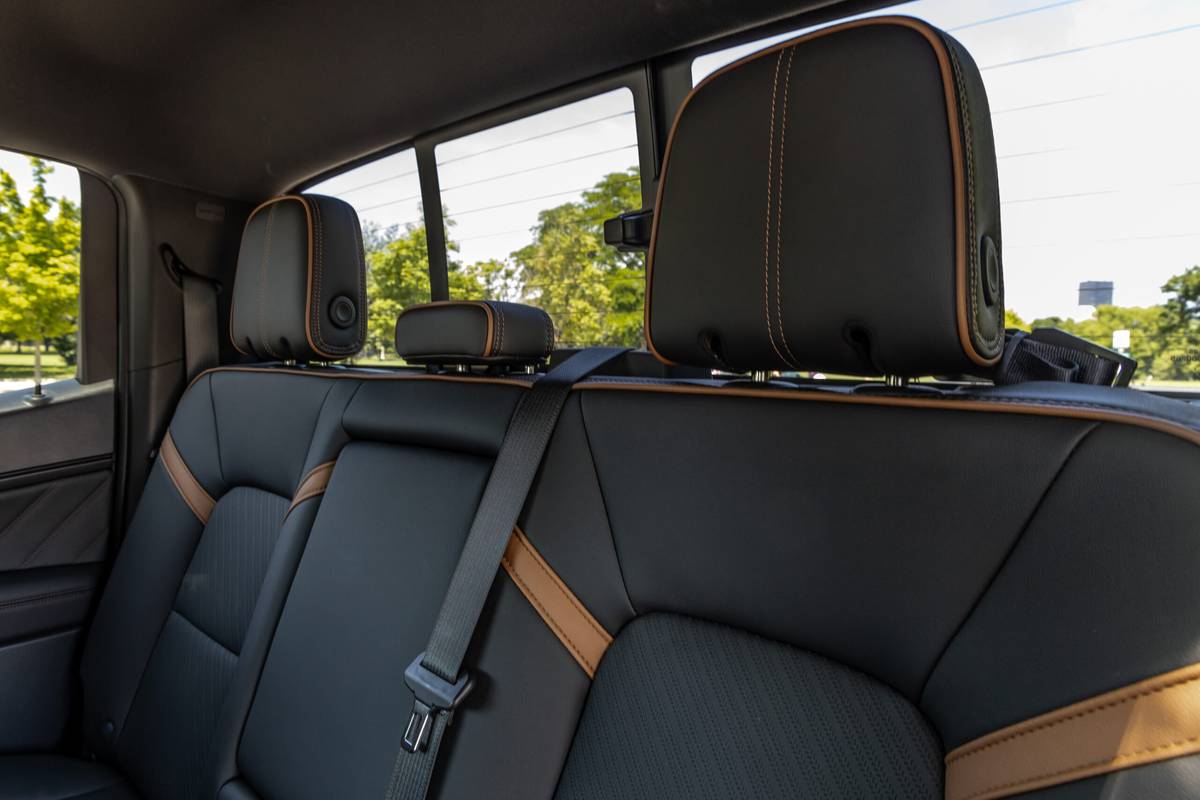
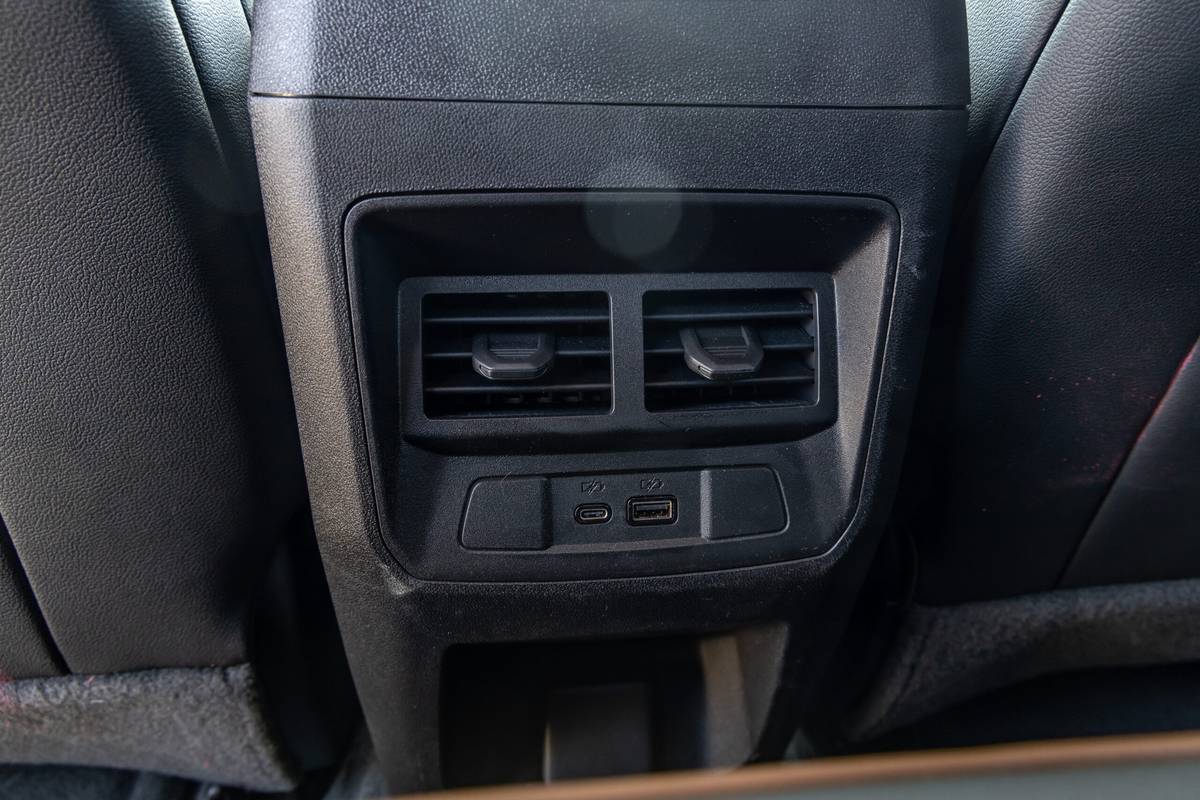
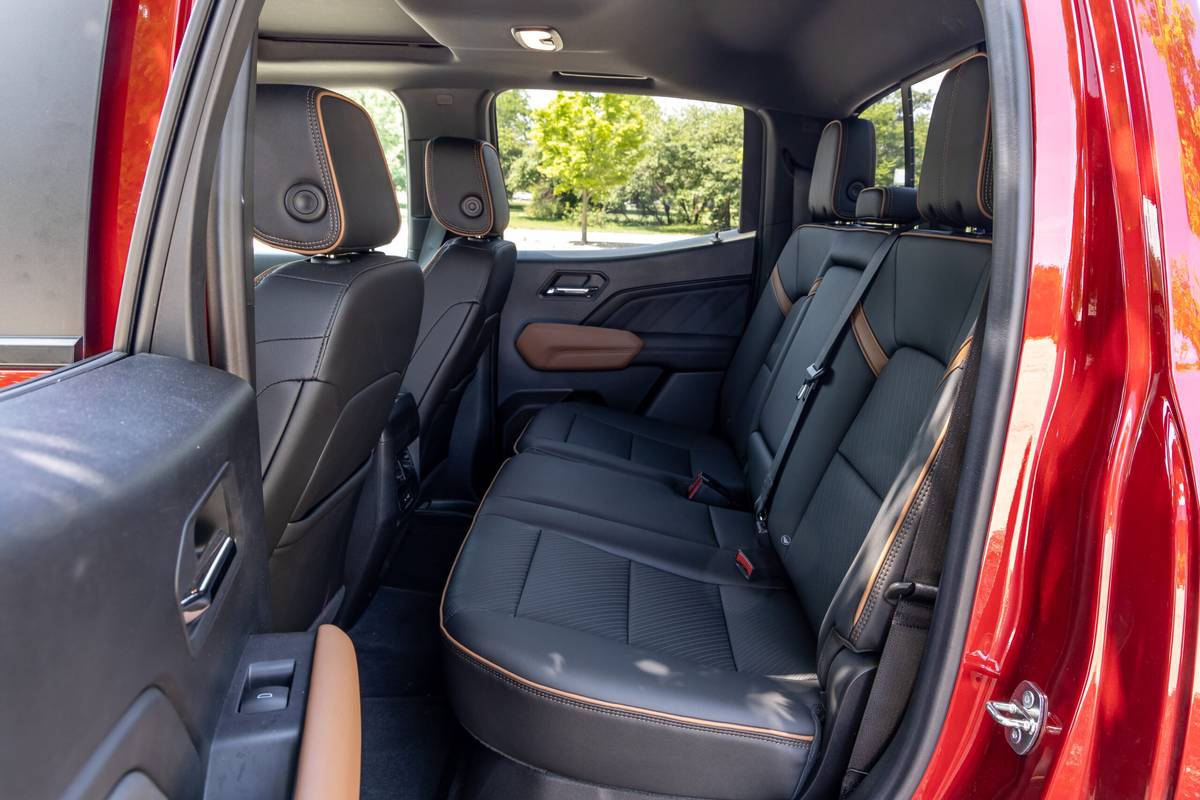
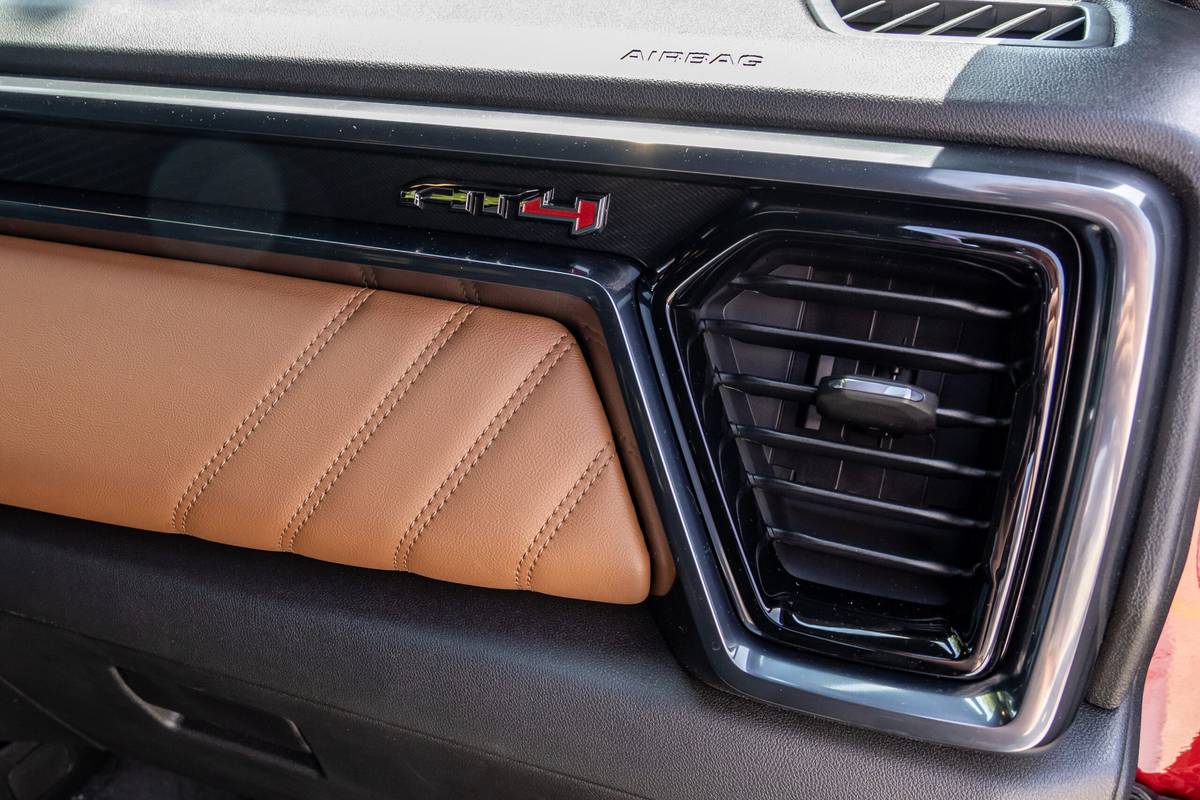
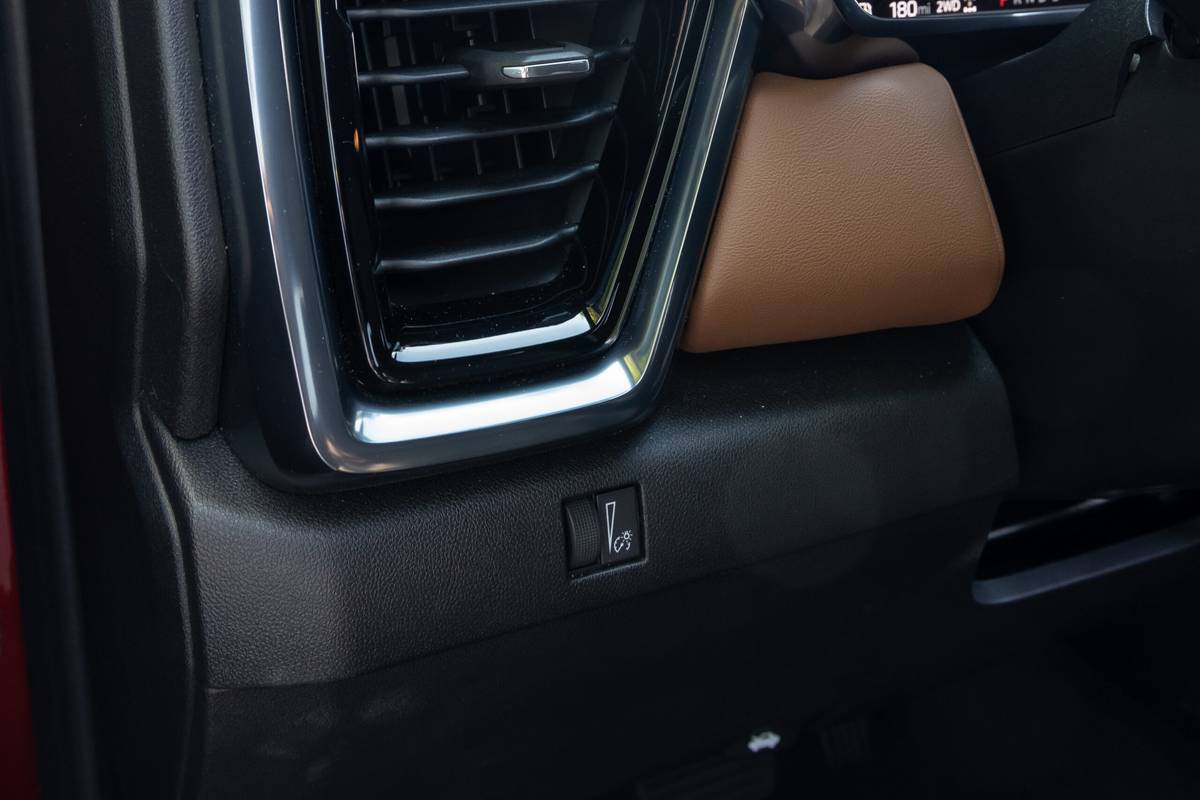
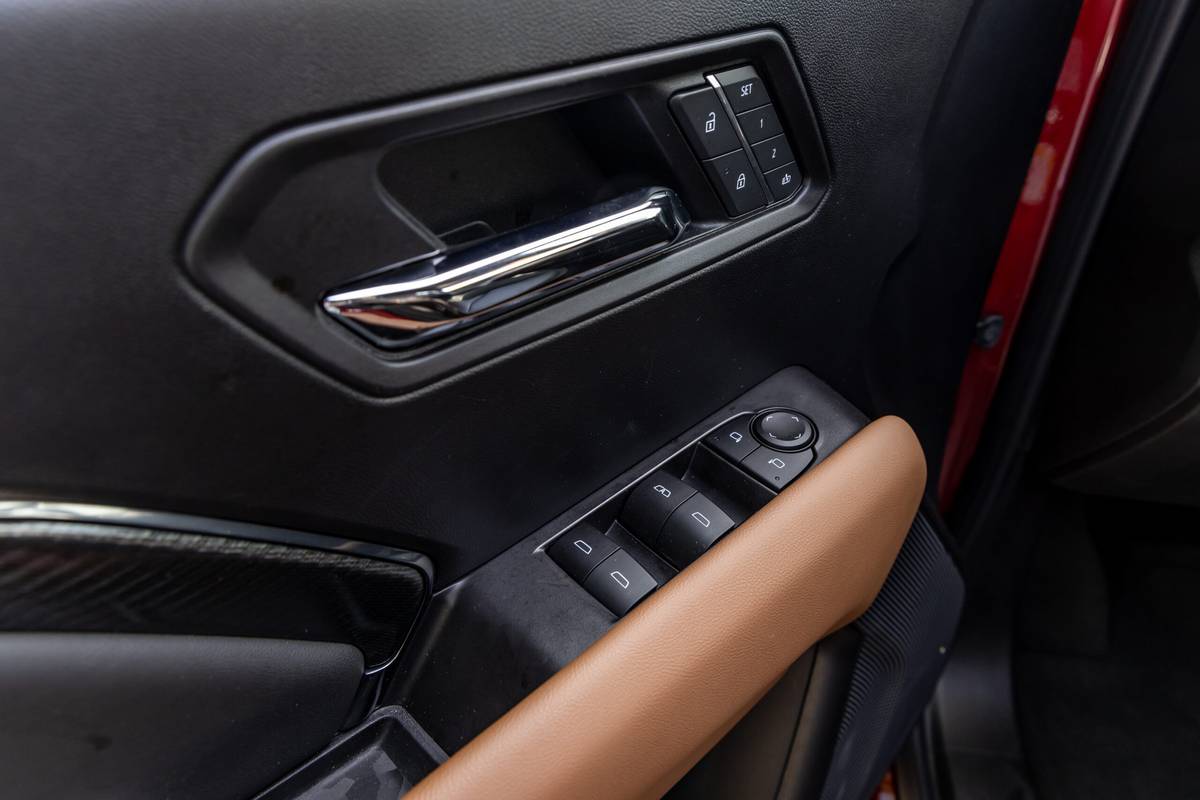
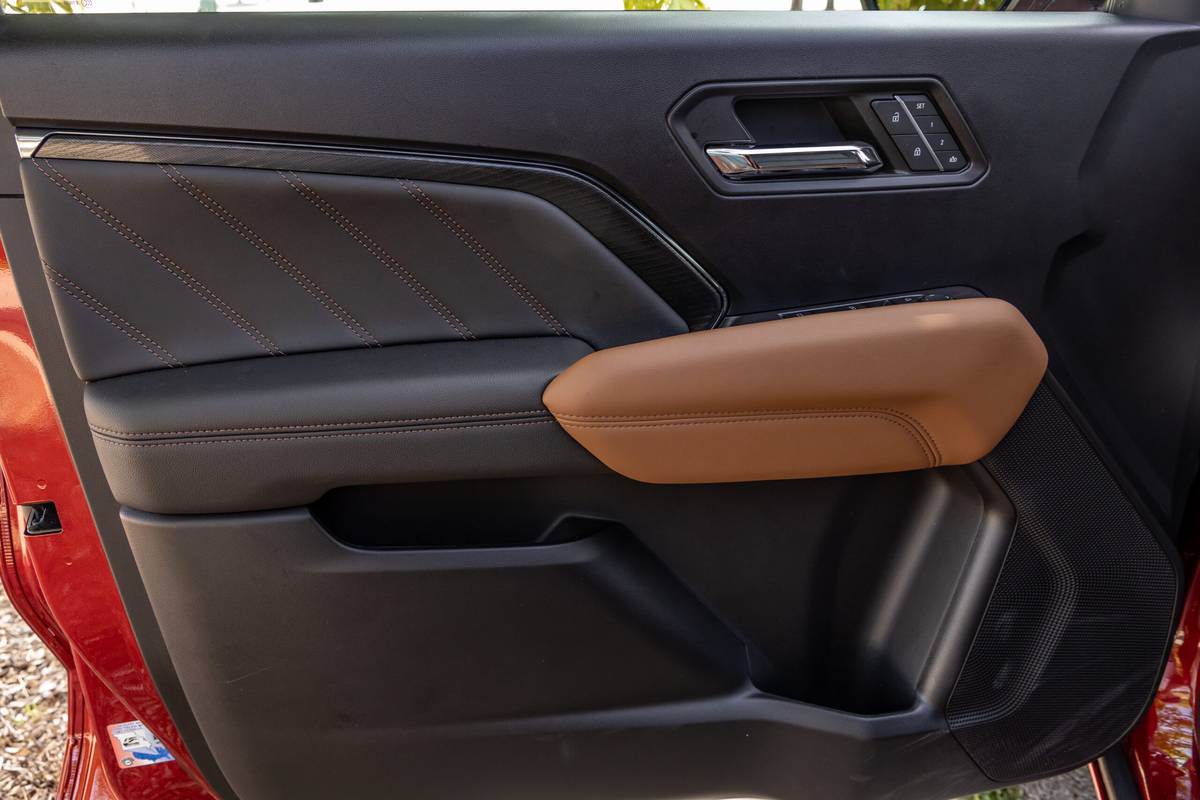
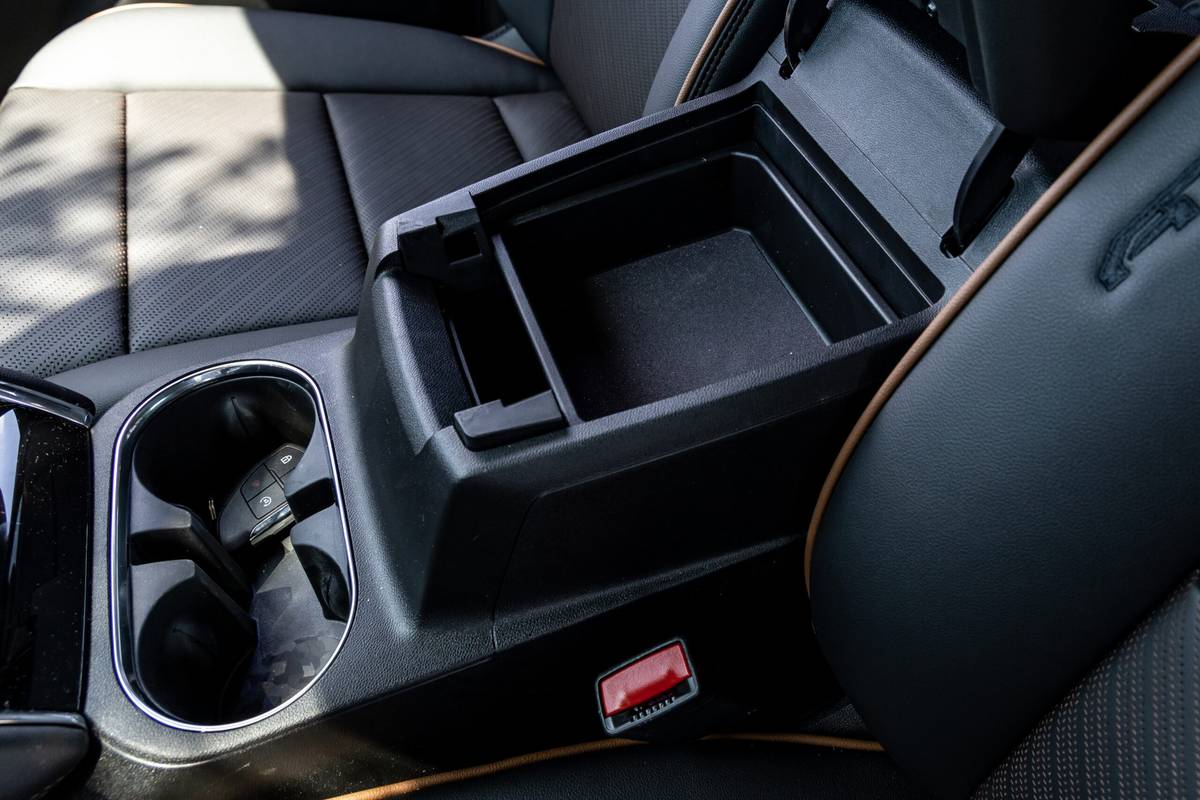


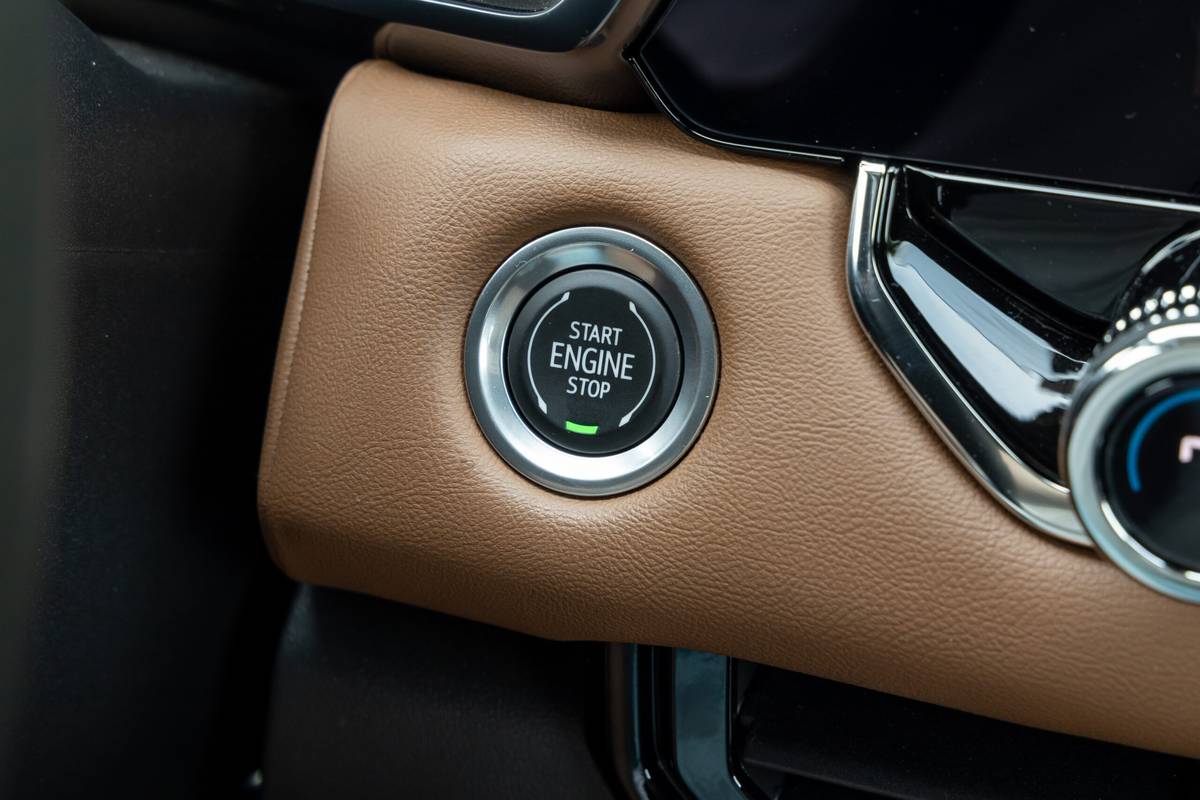
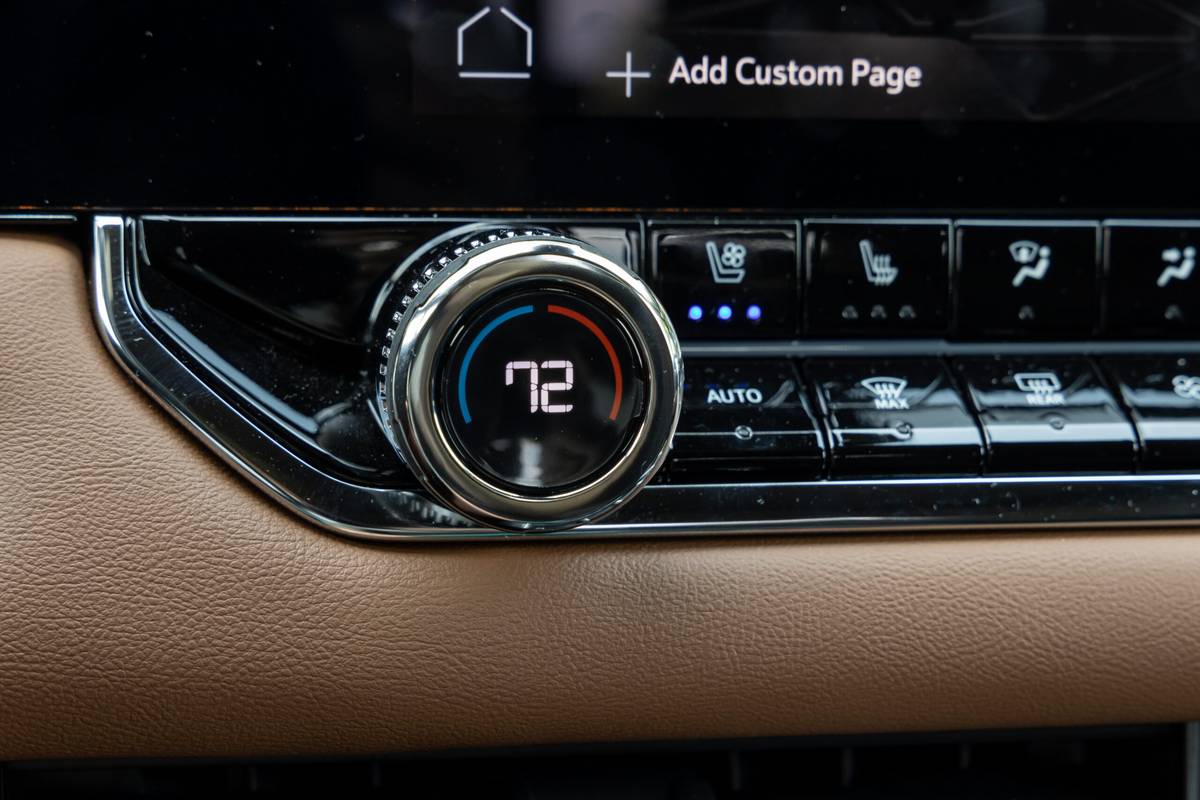

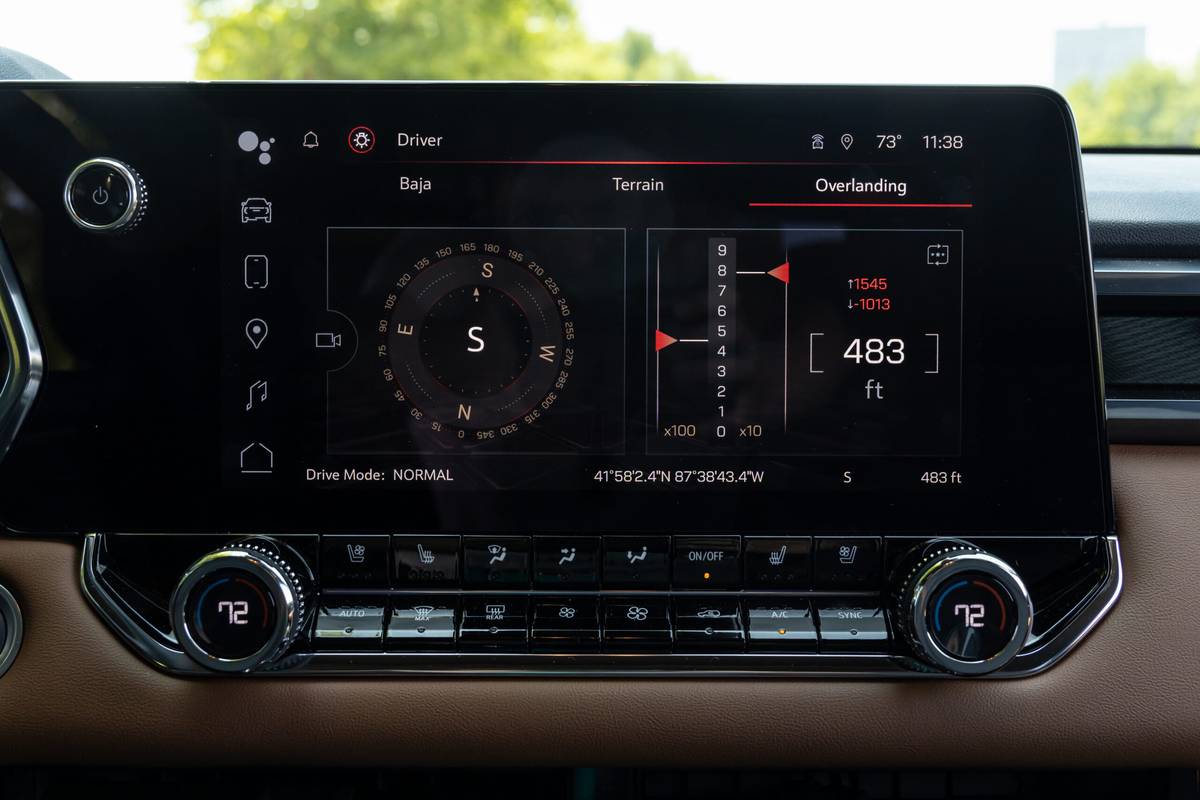
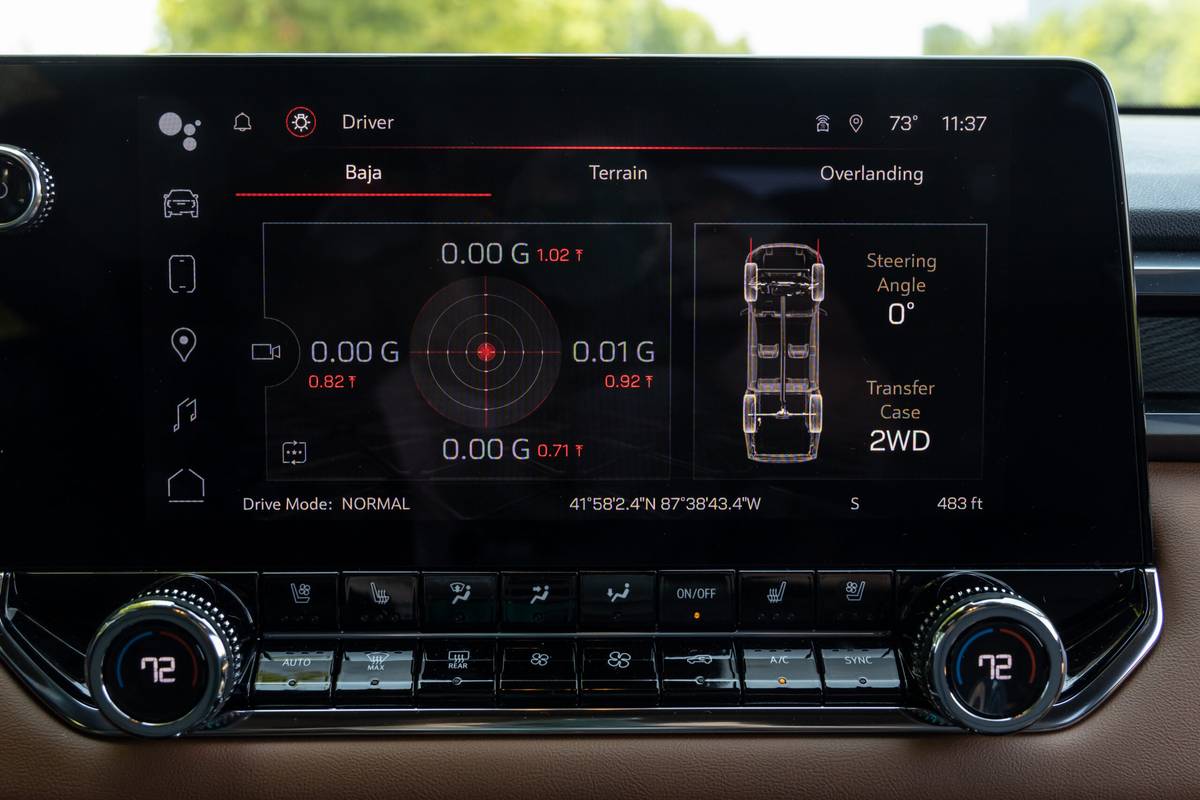

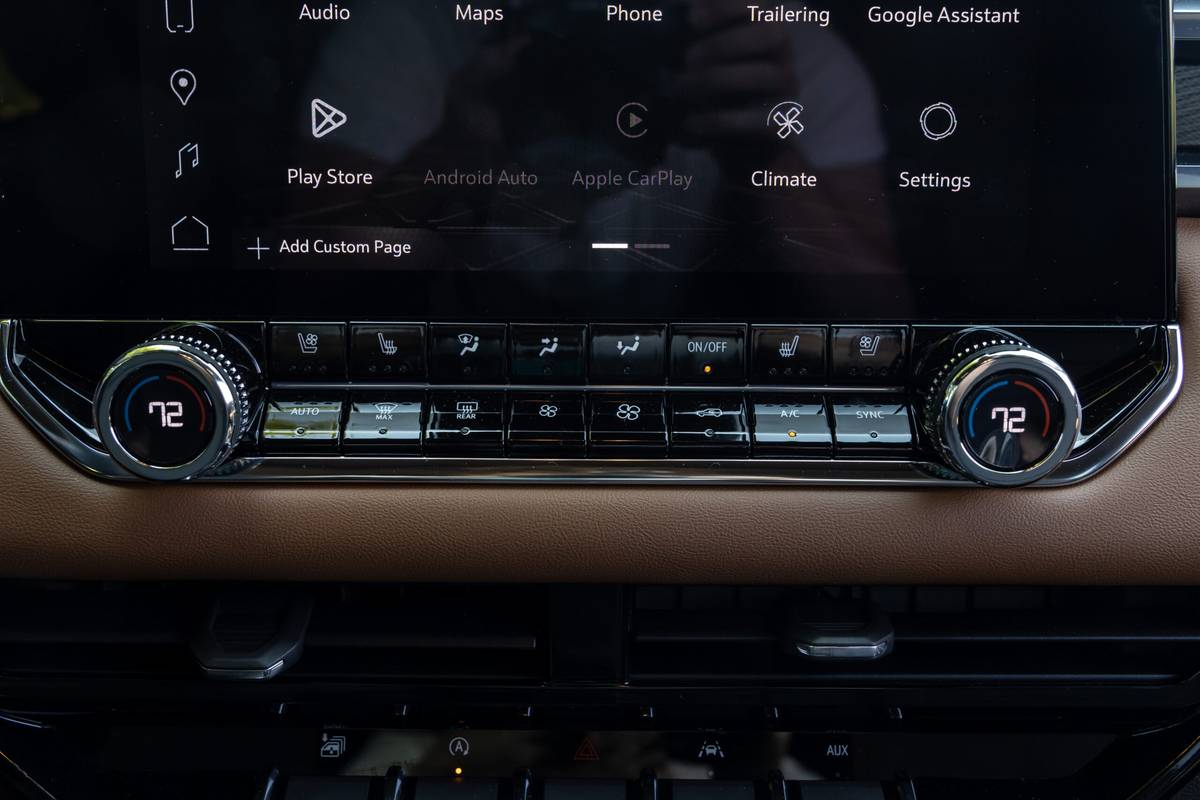
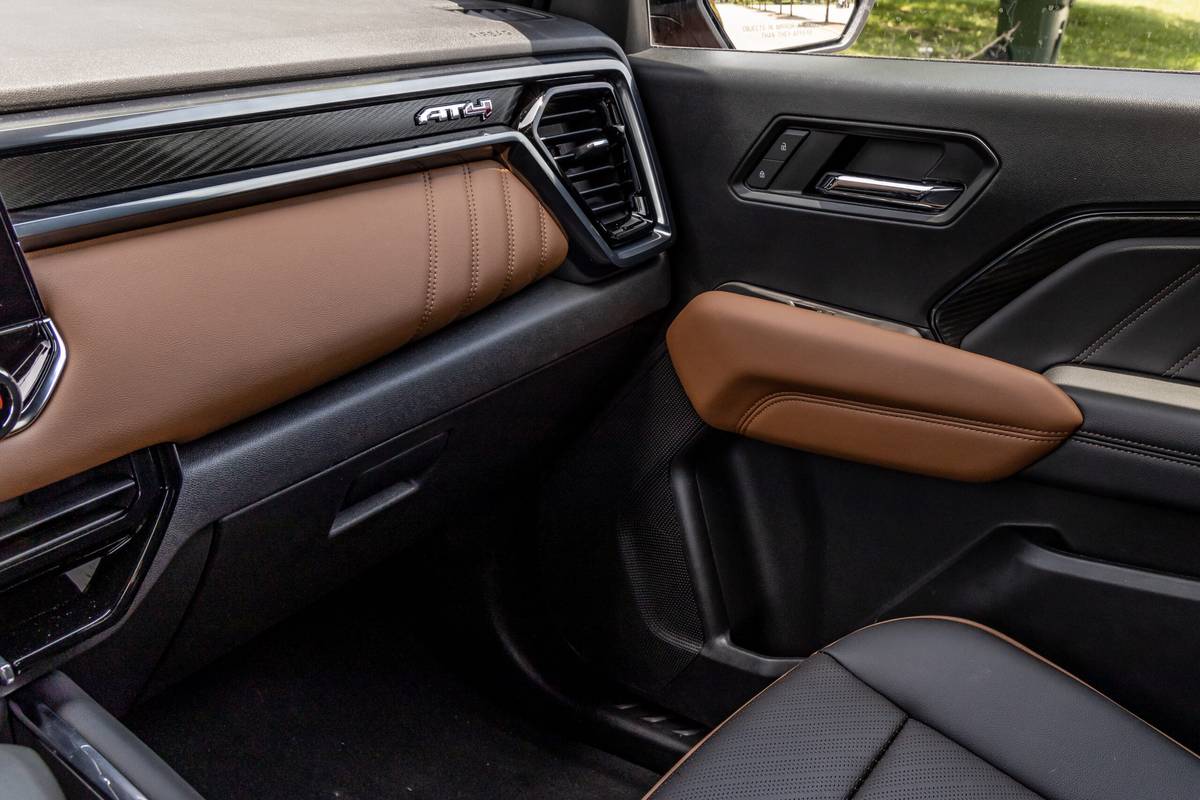
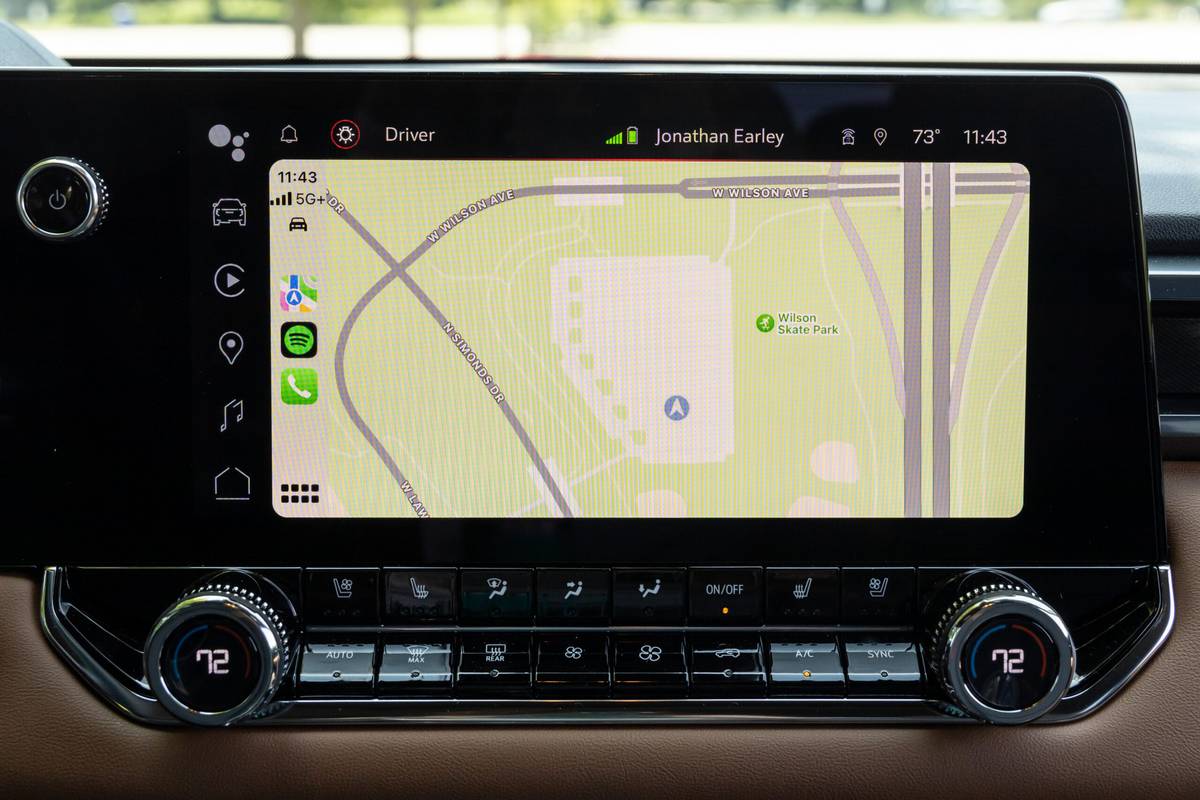
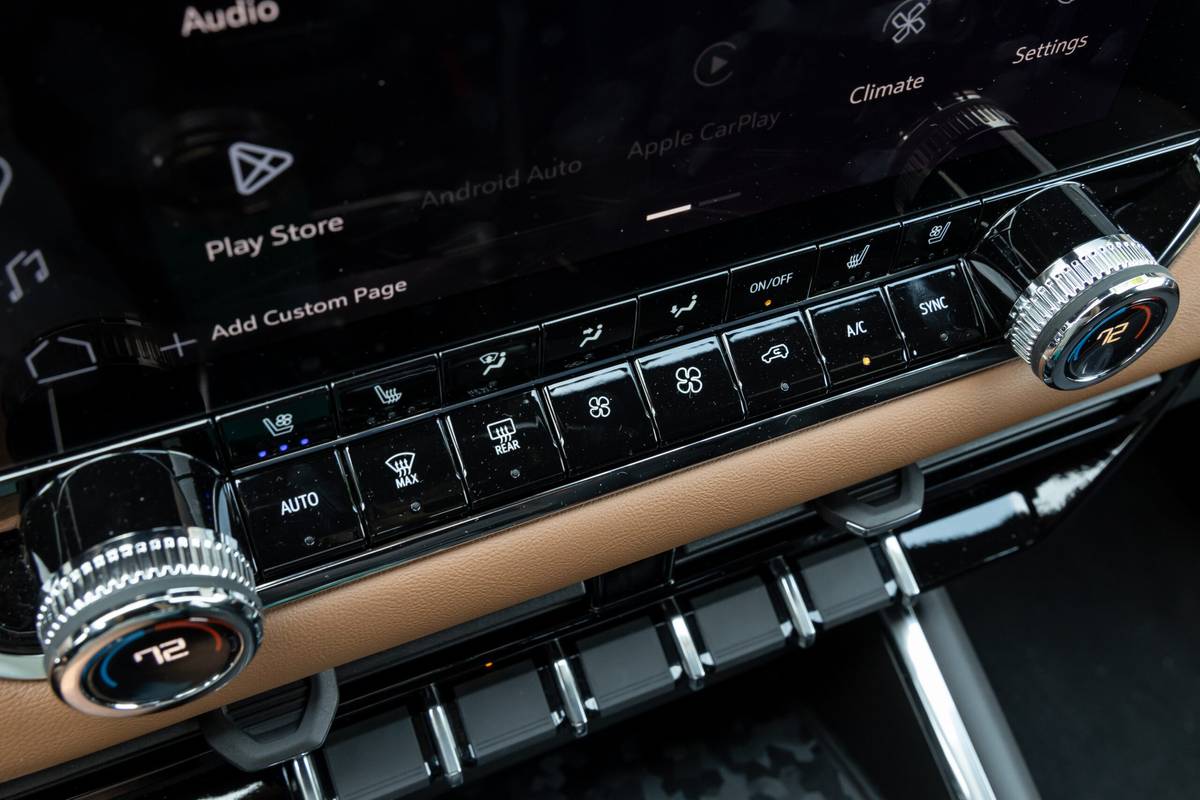
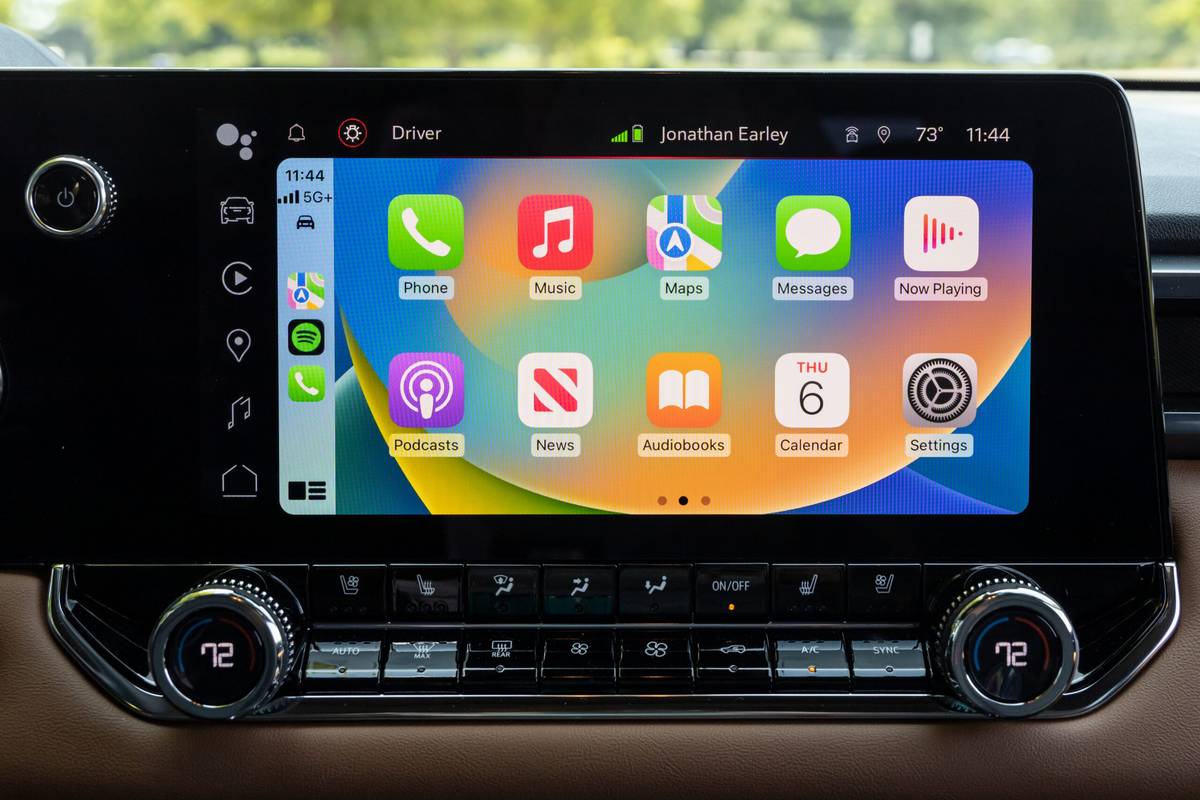
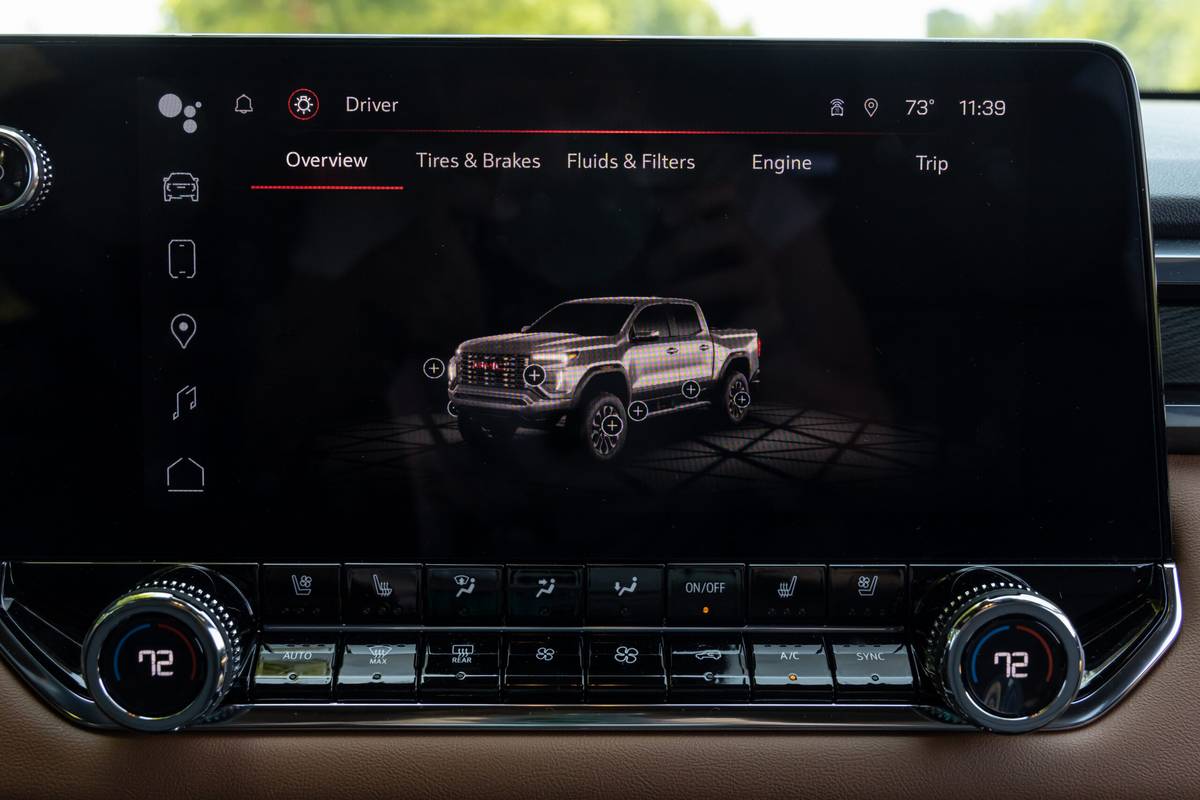

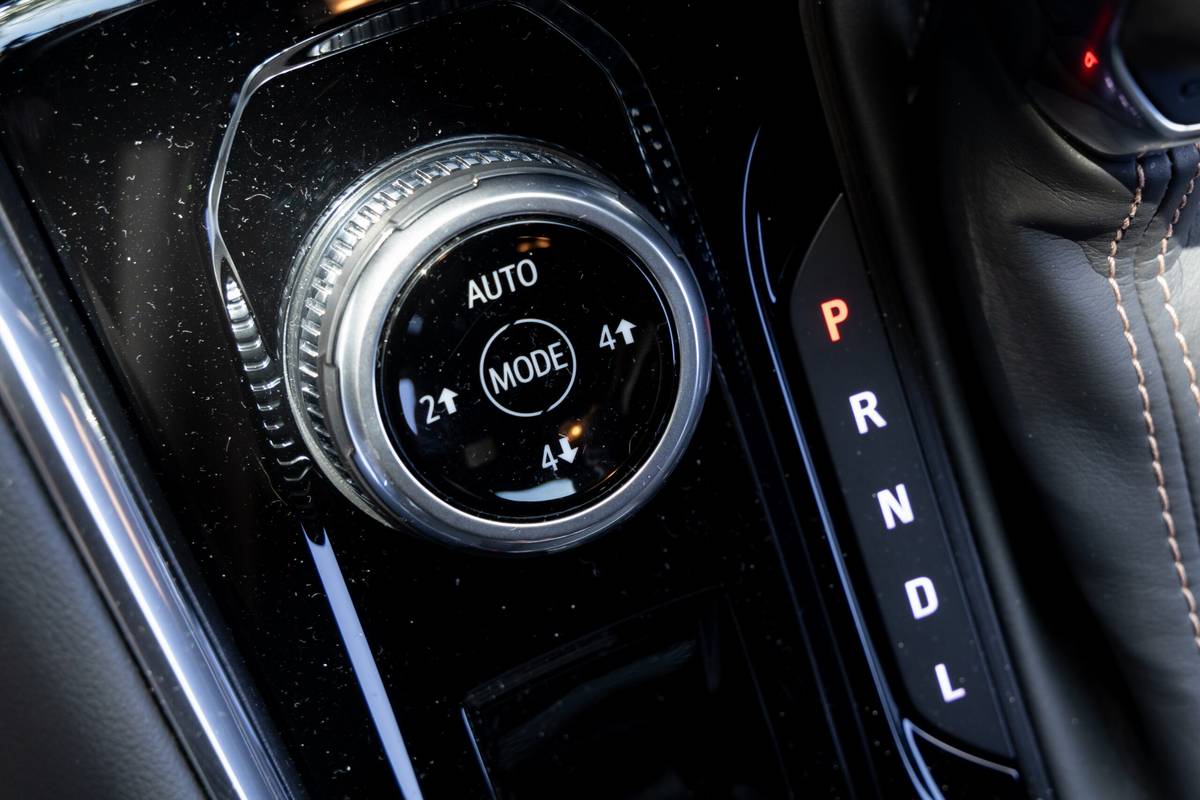
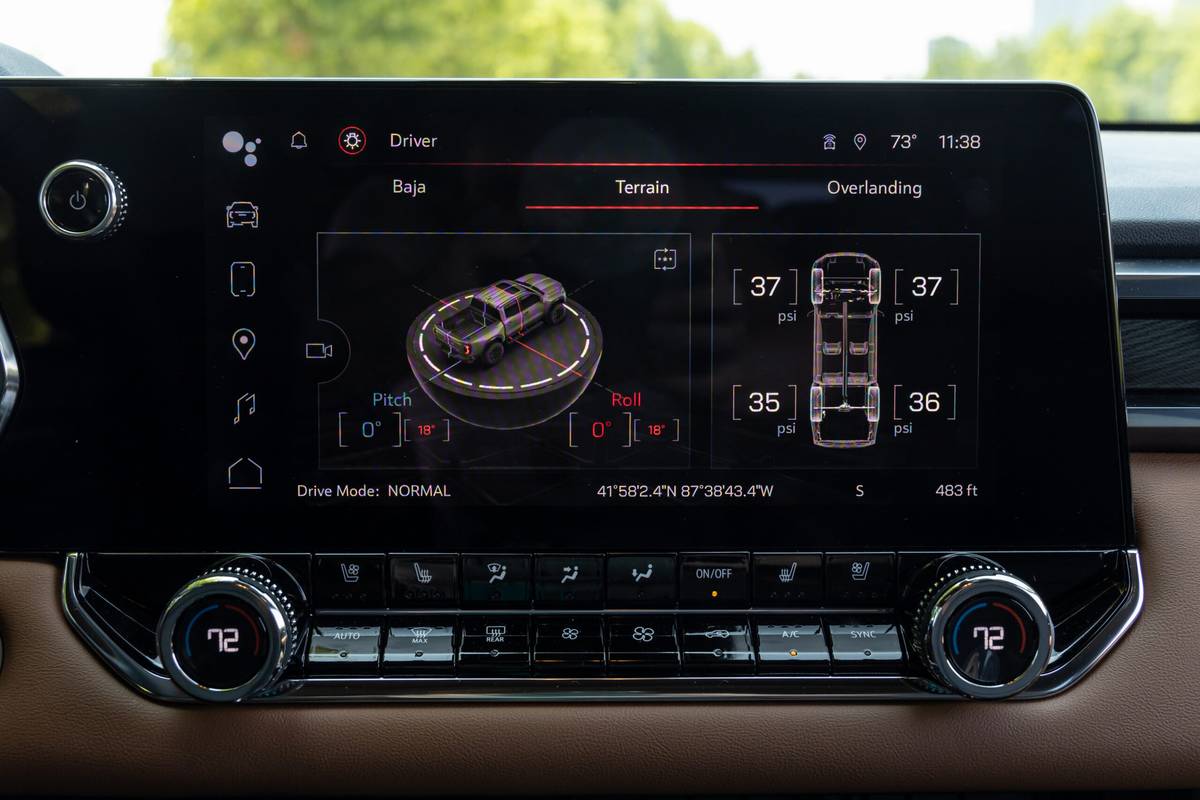
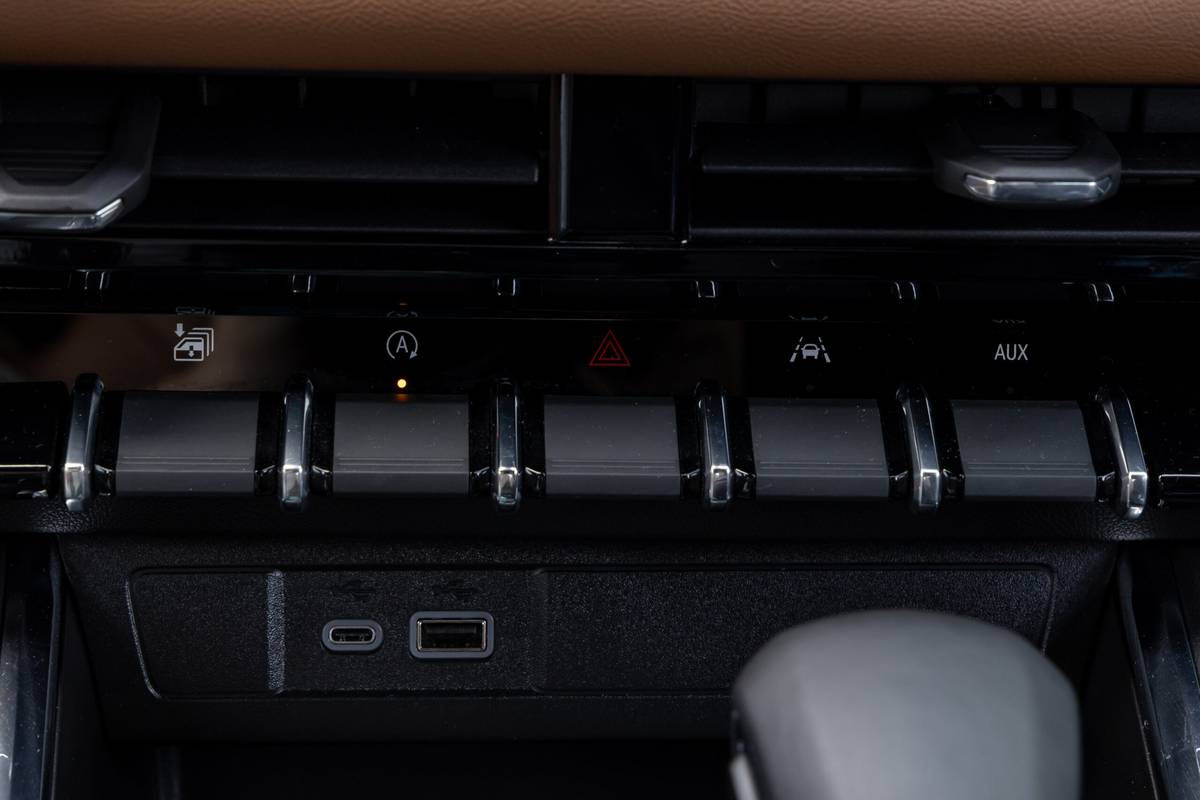

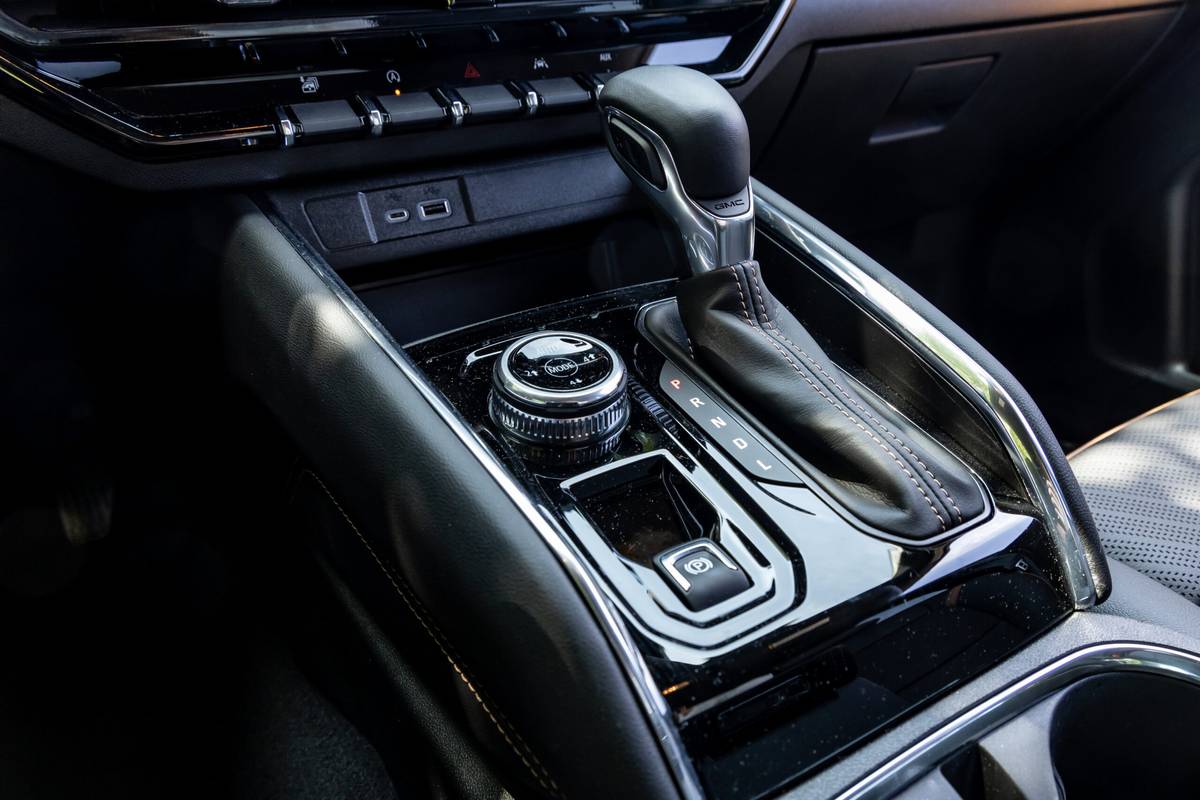
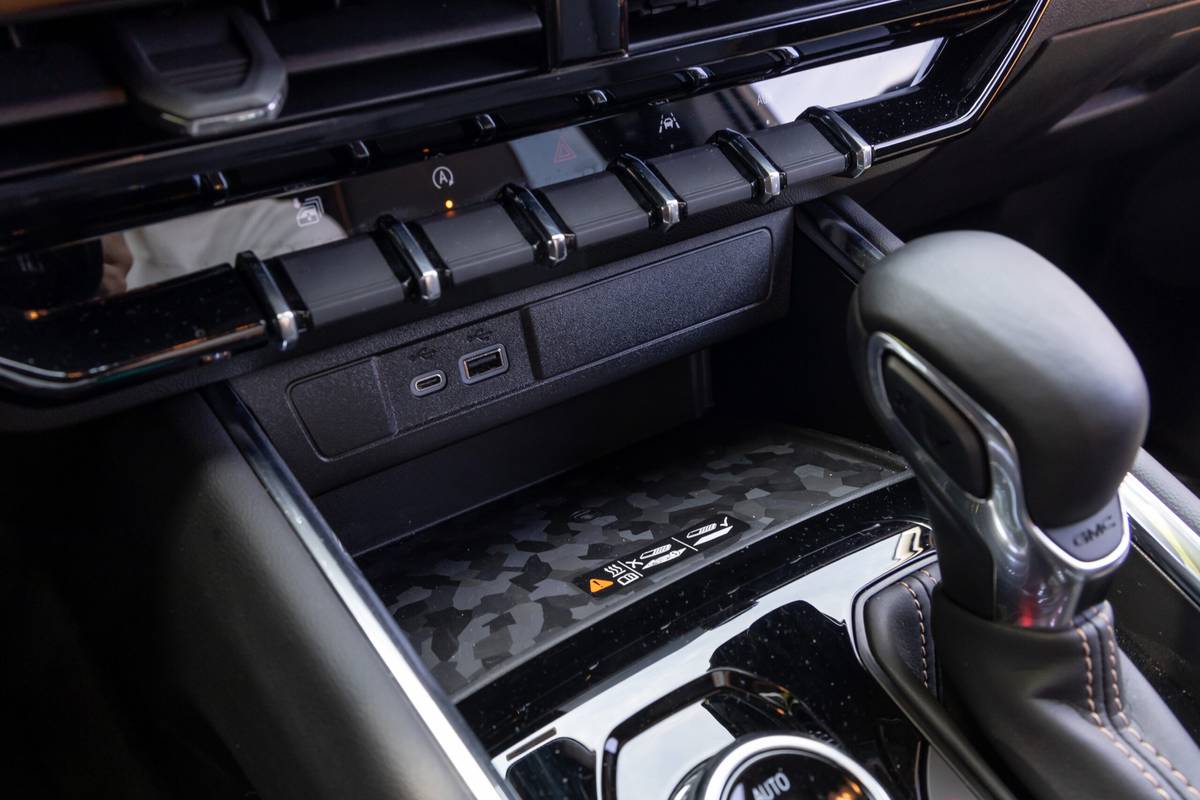
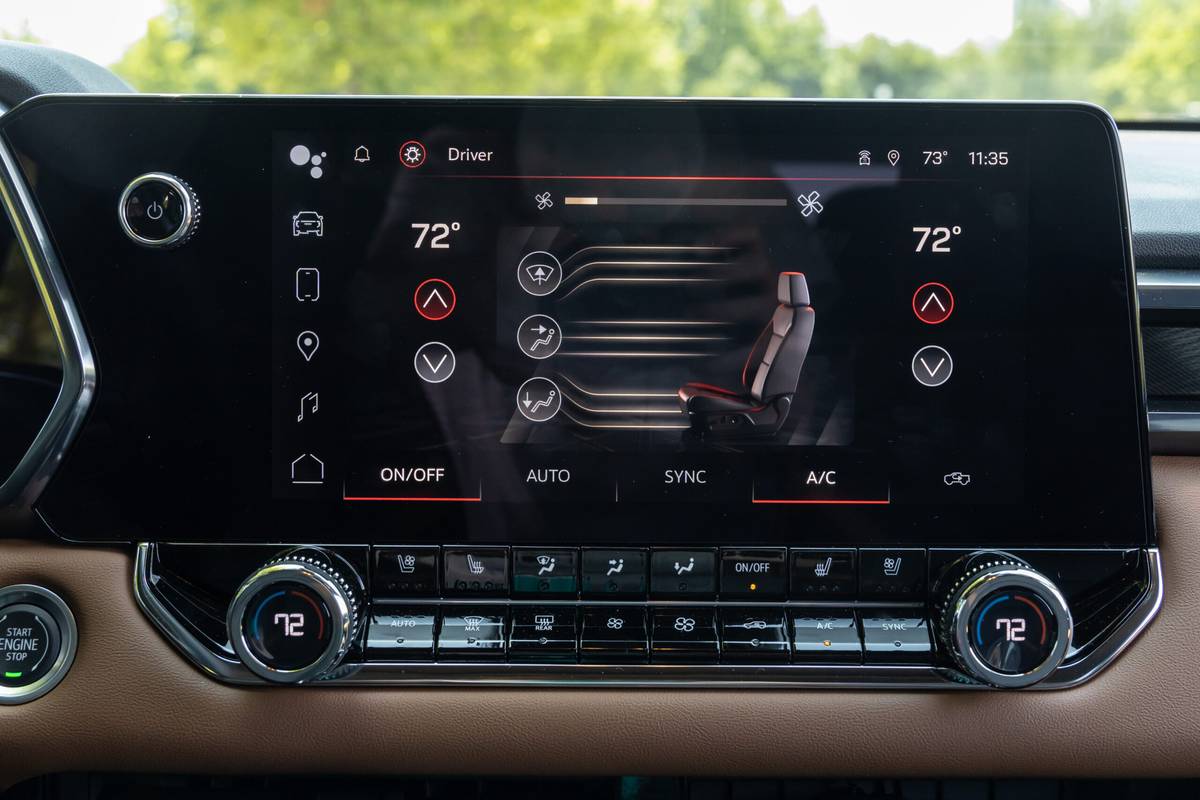
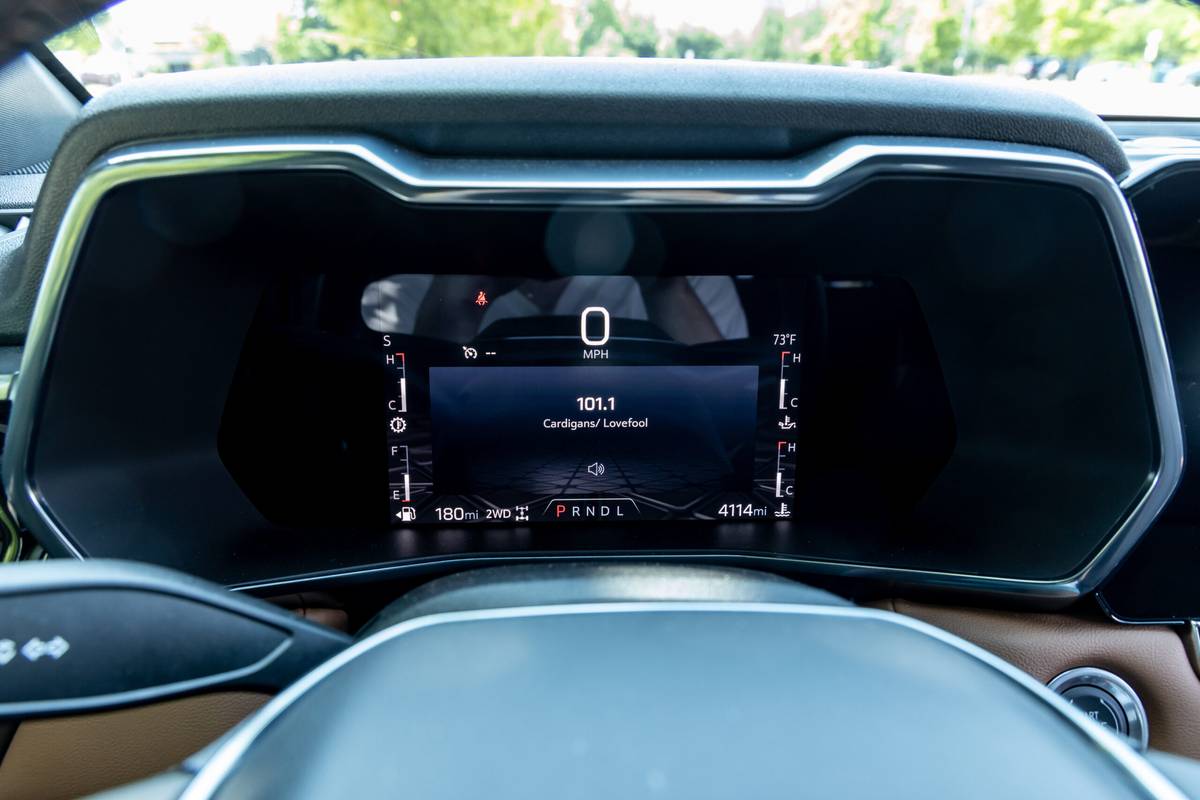
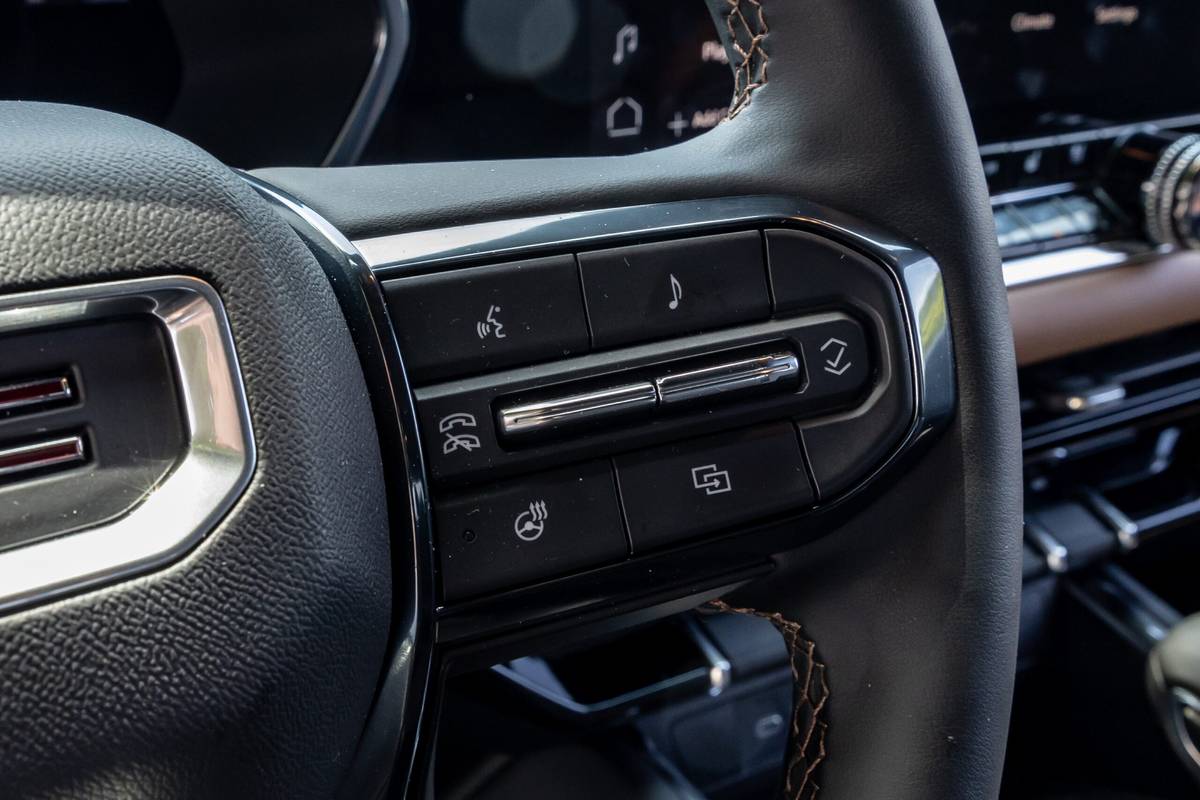
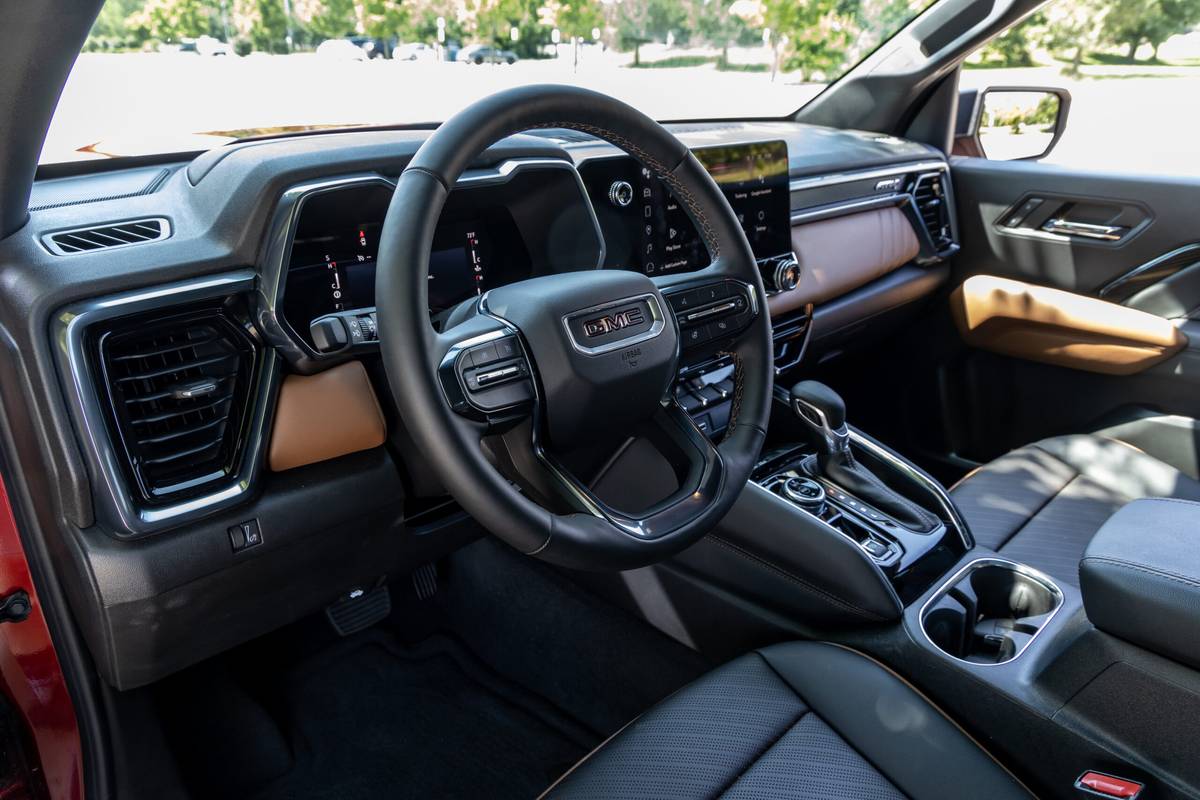
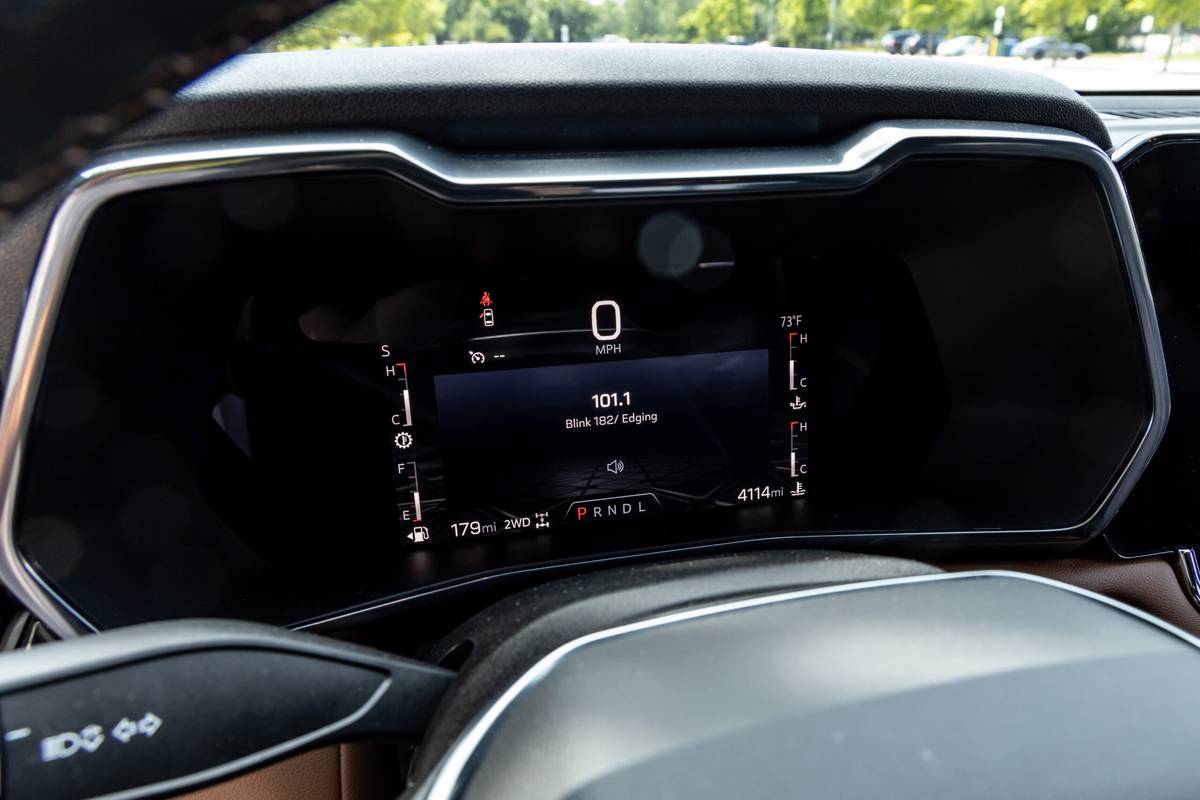
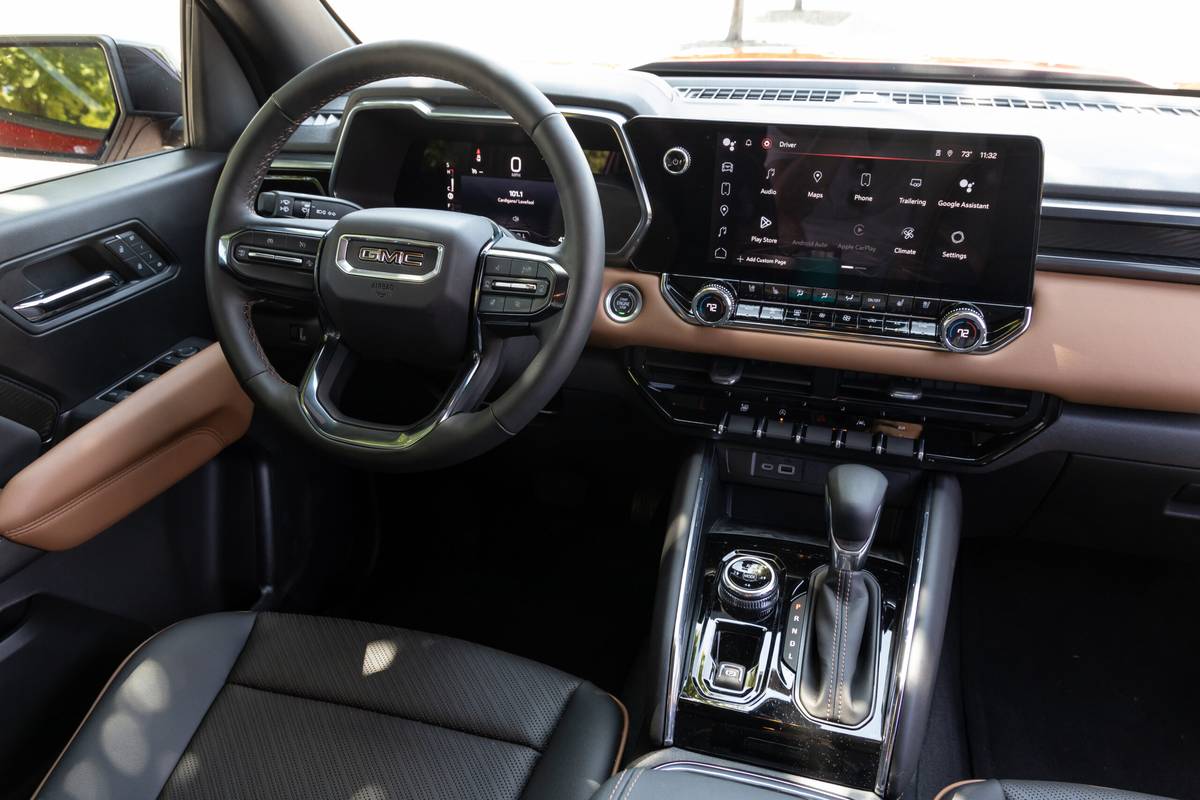
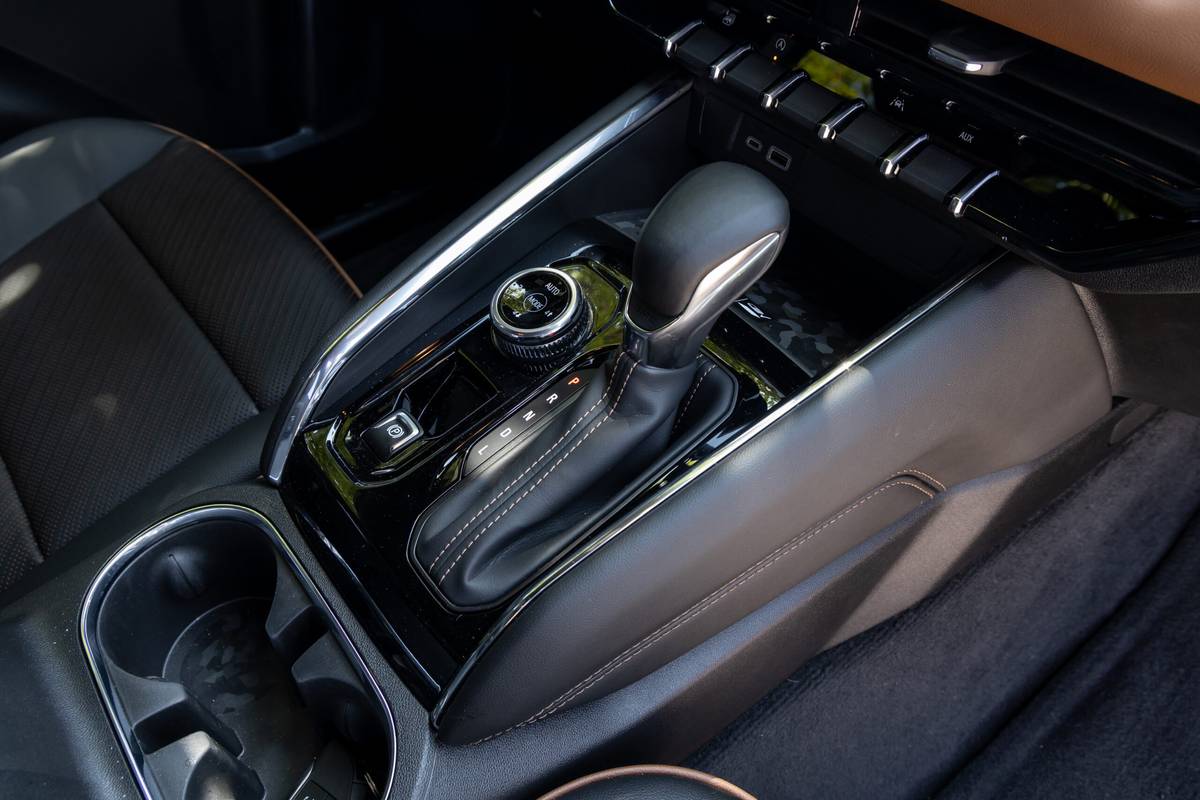
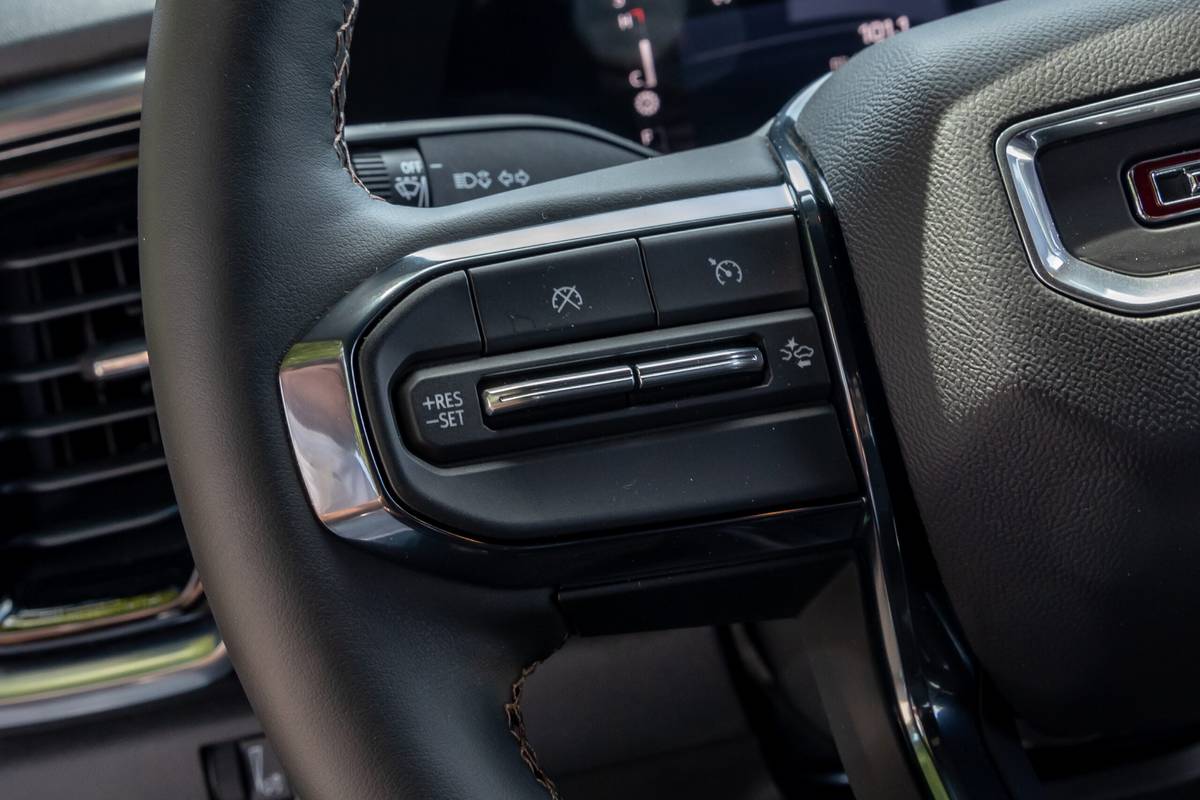

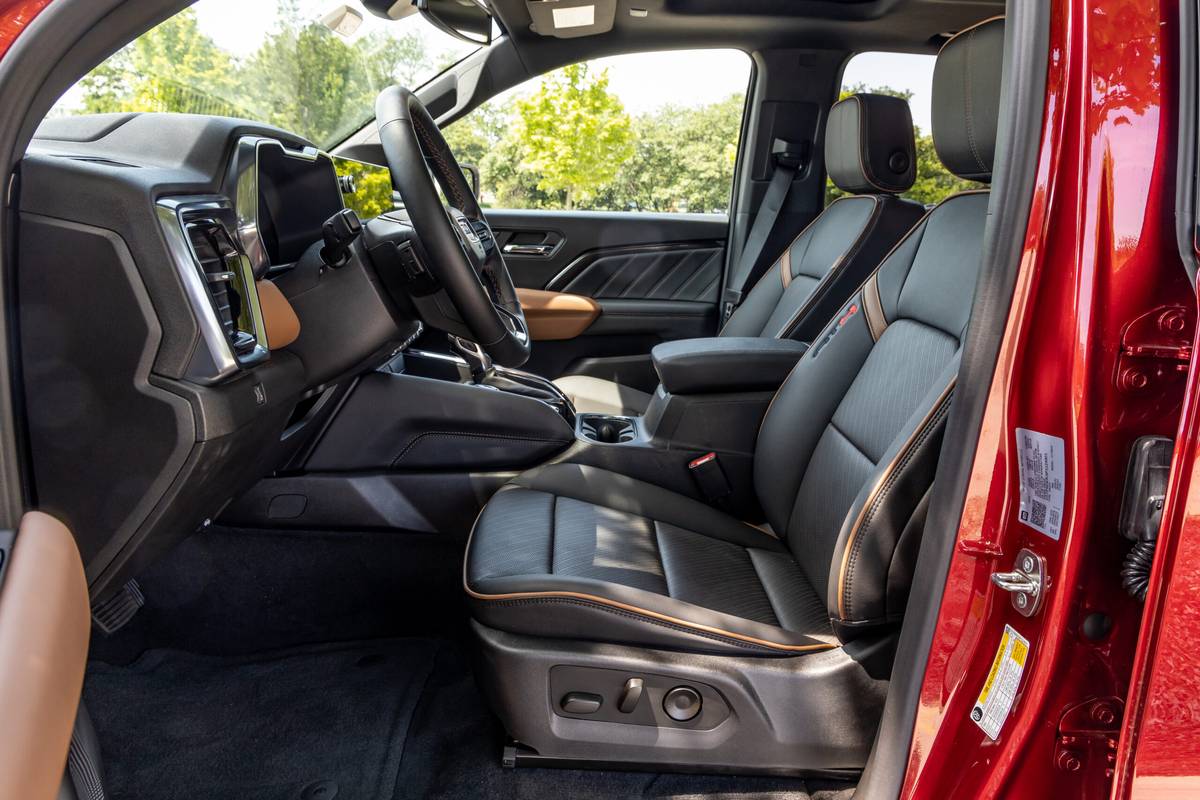
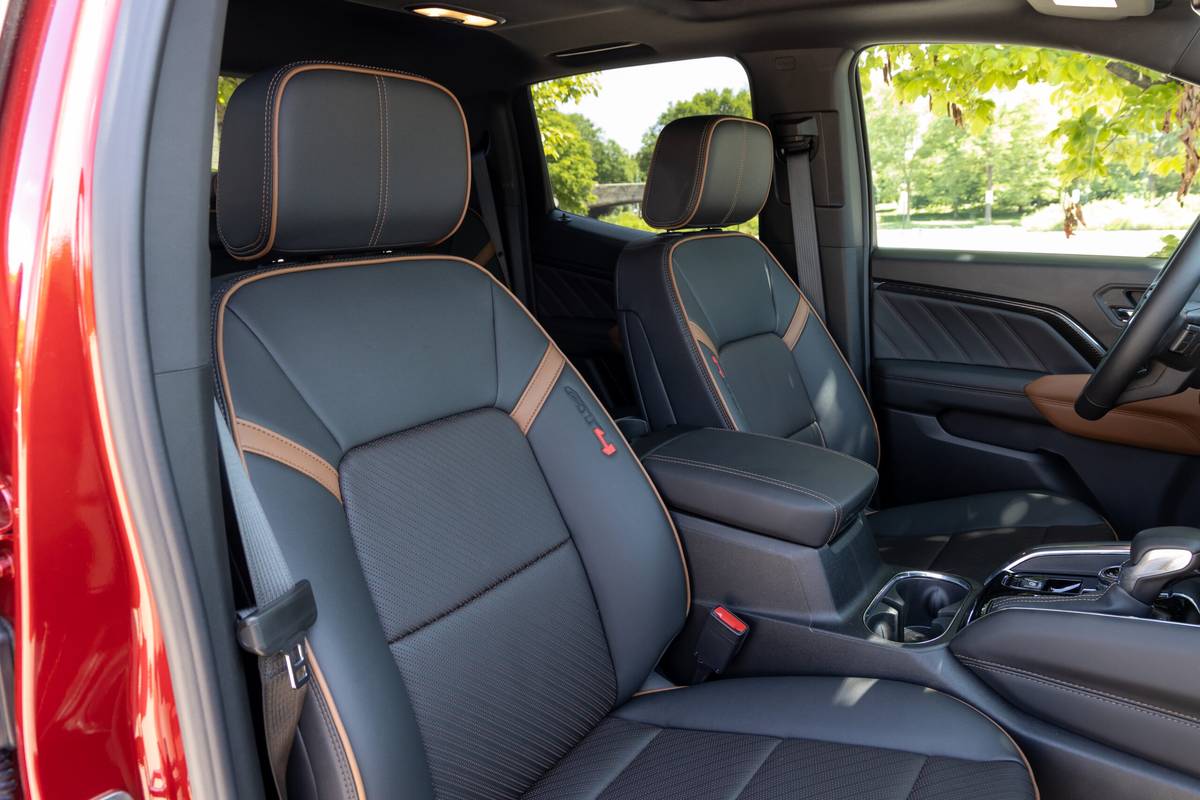
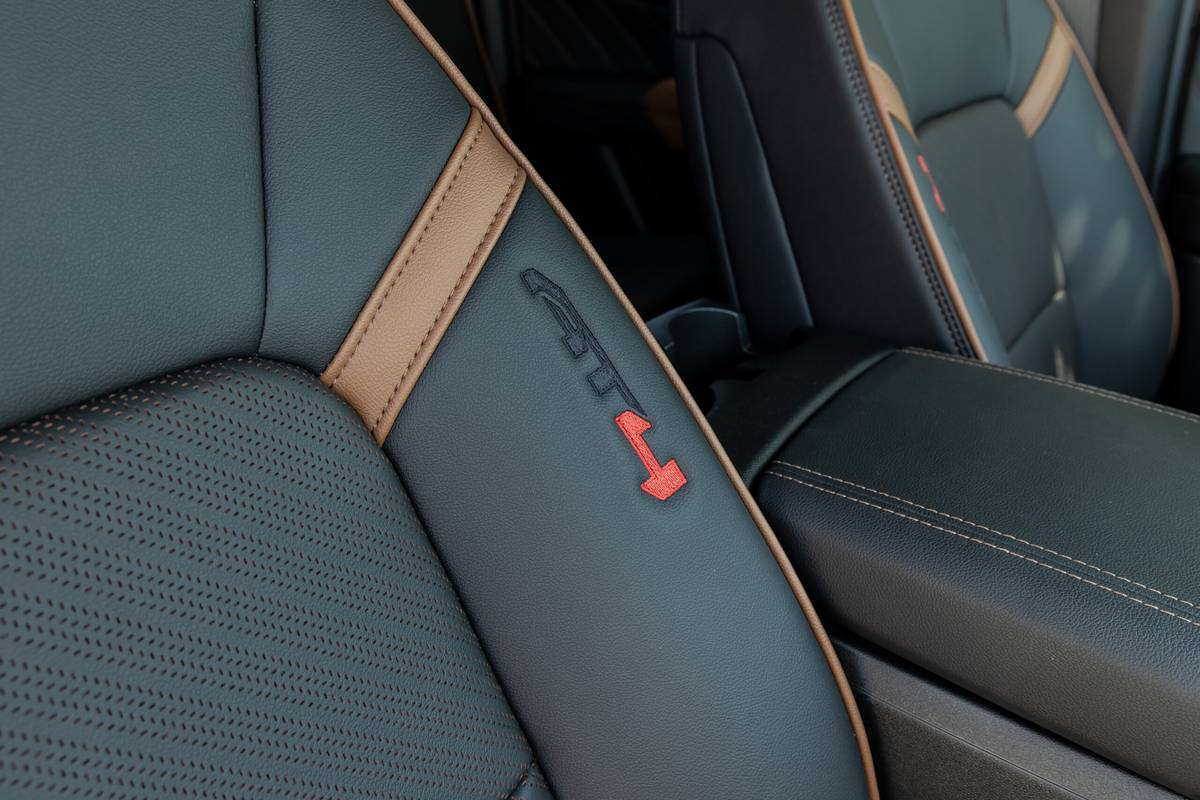
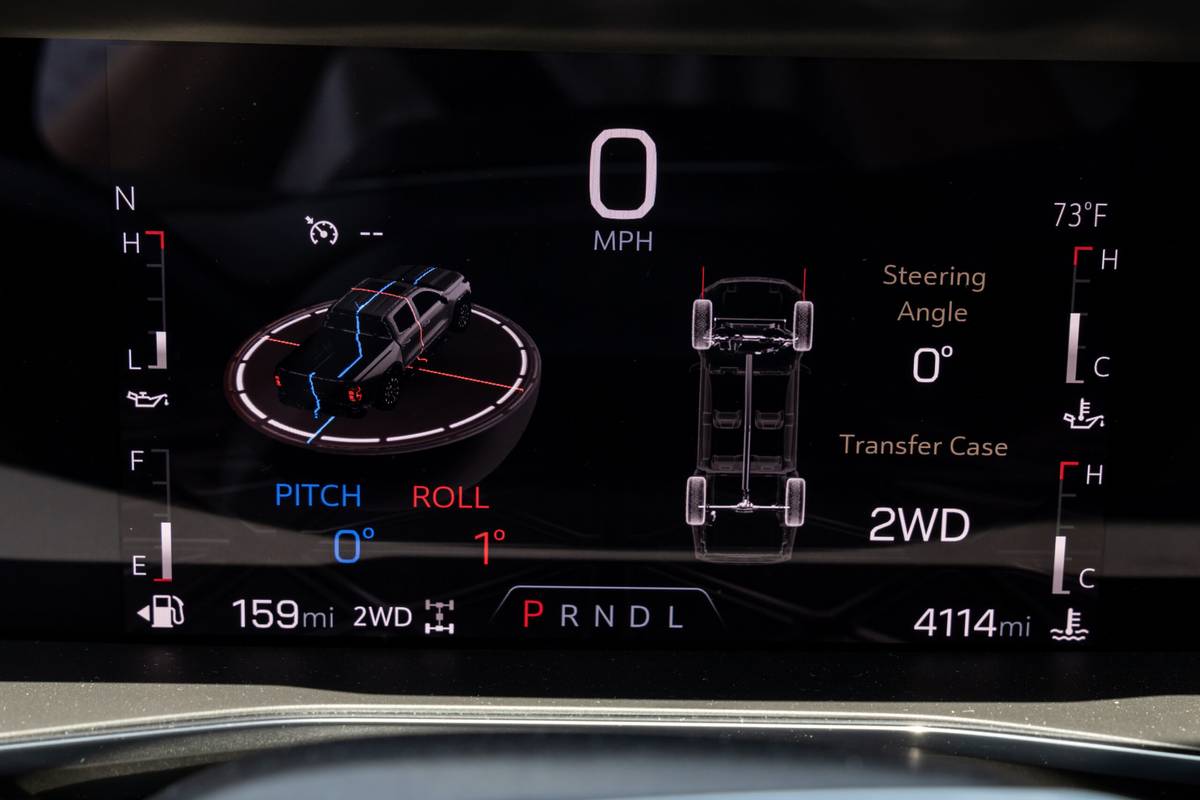
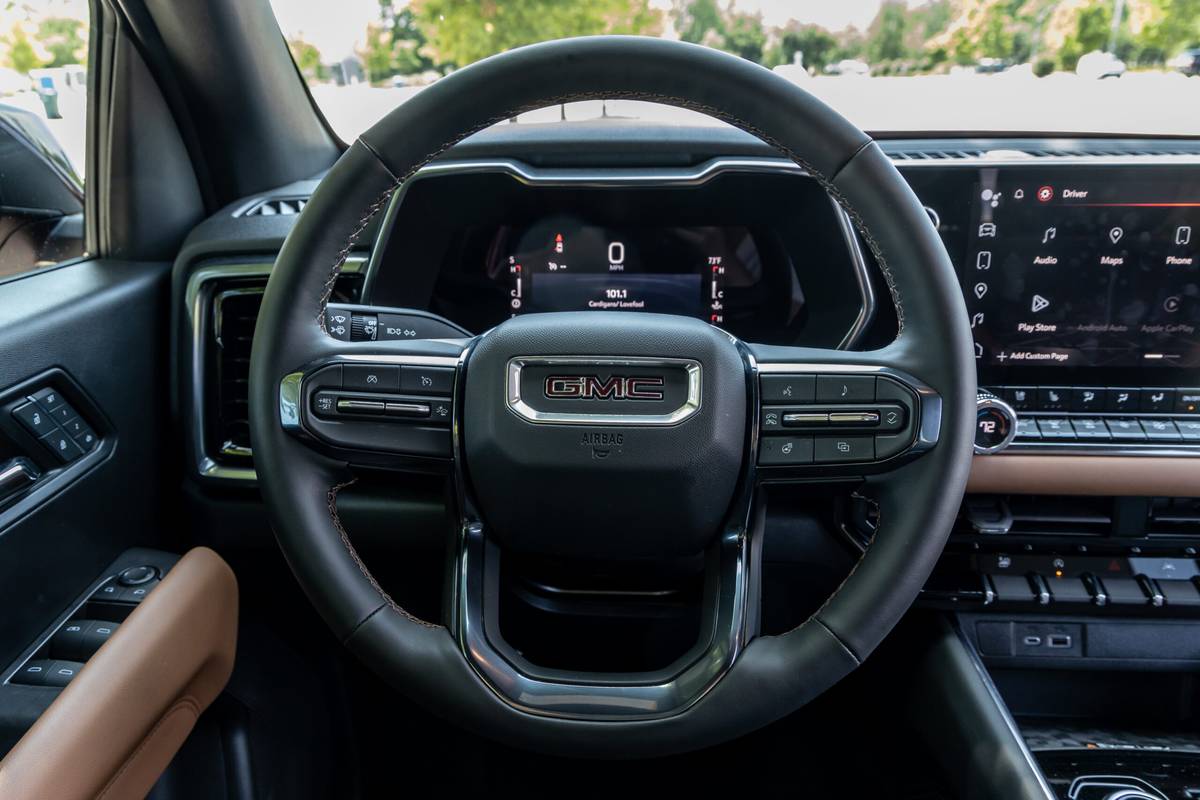

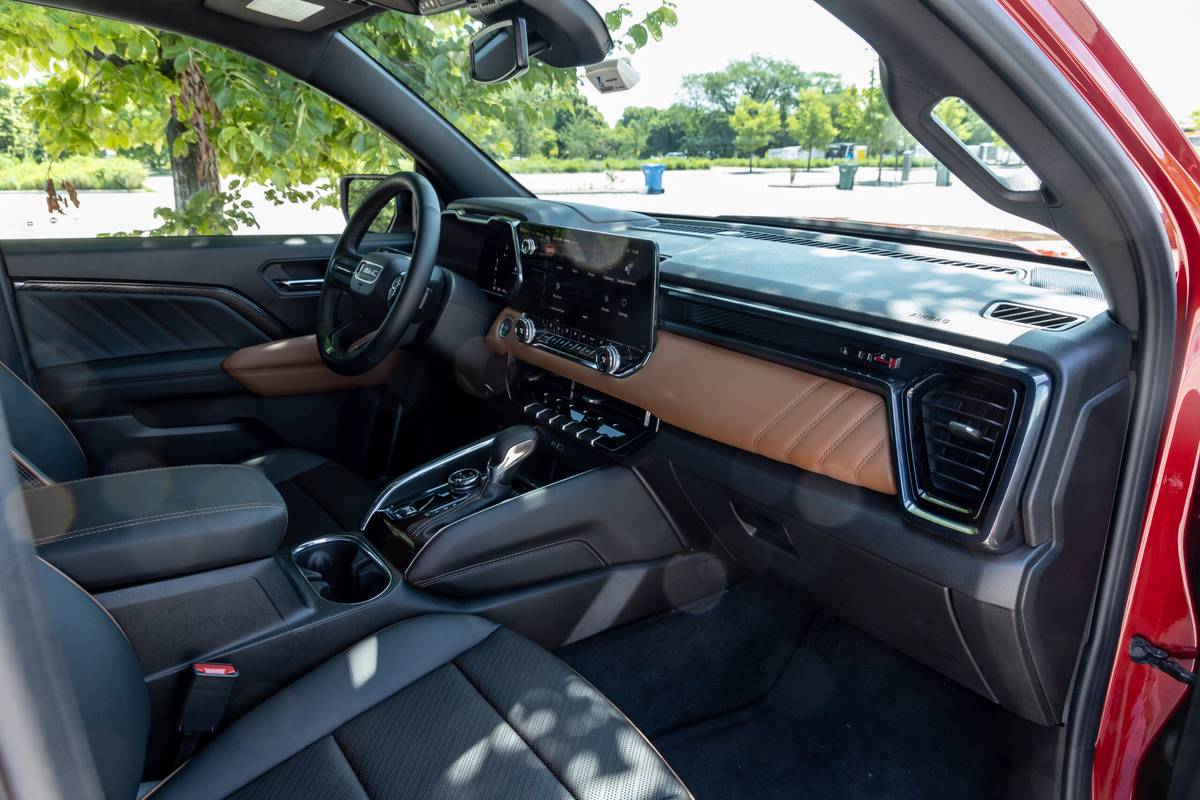













































With a standard 11.3-inch touchscreen, the Canyon’s in-cabin technology is also sufficiently premium. The touchscreen is responsive, with crisp and clear graphics, and the infotainment system includes standard wireless Apple CarPlay and Android Auto. Unfortunately, it also includes most of the headlight controls in a permanent position at the top of the screen. The logic is clear: With standard automatic headlights, you don’t need physical controls; just set the lights to Auto and forget about them. The high beams can still be turned on and off using a column-mounted stalk, though they also have an automatic mode, but other light controls are left to the screen. Less frequently used ones, like the on-off switch for the automatic high beams, even require a few selections to access. Set it and forget it or not, I’d prefer not to have a screen failure come between me and full control of my truck’s headlights.
The backseat is also not as roomy as it was in the previous Canyon. It’s still fairly comfortable for adult passengers, but the smaller size is confusing given the truck’s larger overall dimensions. Up front, the seats were comfortable for shorter drives but less so for longer ones — even with this truck’s cushy ride.
Feels Bigger Than Mid-Size
The 2023 Canyon’s suspension lift also contributes to the truck’s commanding driving position: The Canyon’s AT4 trim level is taller than any configuration of the otherwise-larger 2023 GMC Sierra 1500. The seating position is a positive in terms of visibility, but it also contributes to something that bothered me throughout my time in the Canyon: It doesn’t feel smaller than a Sierra 1500. Navigating streets, traffic and parking lots in this truck felt similar to doing so in a full-size pickup. It had me longing for our old long-term Ford Maverick, which is a conveniently sized small truck.
The Maverick isn’t, however, quite as capable as the Canyon; while its maximum payload capacities are similar, the Canyon has a maximum towing capacity of 7,700 pounds versus the Maverick’s 4,000-pound maximum. As you might expect, the Canyon isn’t as capable as the Sierra 1500, lagging in both towing and payload capacities even when the Sierra is fitted with its 2.7-liter engine (which oddly makes less torque than the Canyon’s).
With a similar feel to a full-size pickup, the Canyon loses a lot of its appeal as a smaller alternative for an everyday truck; most of its remaining appeal comes from its off-road attributes.
More From Cars.com:
- 2023 GMC Canyon: Who Needs Roads?
- 2023 GMC Canyon Packs Value Into Rugged Package, Starts at $38,395
- GMC Ups Off-Road Ante With 2024 Canyon AT4X AEV
- New 2024 AT4X AEV Edition Is Most Extreme GMC Canyon Yet
- 2023 Chevrolet Colorado Review: New Style and Substance to Challenge the Tacoma
Mid-Size Price Is Still Pricey
With an as-tested price just south of $50,000 (including destination), the mid-level Canyon AT4 carries a pretty hefty price tag. Base trims of the Canyon and Sierra 1500 are similarly priced, but Canyon buyers get more standard equipment and a more desirable cab style for their money. A four-wheel-drive Sierra 1500 with the 2.7-liter engine, sans off-road goodies, is around $5,000 more. As blurry as the line between the Canyon and Sierra 1500 has become, when it comes to driving, the Canyon is still the (relative) value pick.
Related Video:
Cars.com’s Editorial department is your source for automotive news and reviews. In line with Cars.com’s long-standing ethics policy, editors and reviewers don’t accept gifts or free trips from automakers. The Editorial department is independent of Cars.com’s advertising, sales and sponsored content departments.

Road Test Editor Brian Normile joined the automotive industry and Cars.com in 2013, and he became part of the Editorial staff in 2014. Brian spent his childhood devouring every car magazine he got his hands on — not literally, eventually — and now reviews and tests vehicles to help consumers make informed choices. Someday, Brian hopes to learn what to do with his hands when he’s reviewing a car on camera. He would daily-drive an Alfa Romeo 4C if he could.
Latest news
